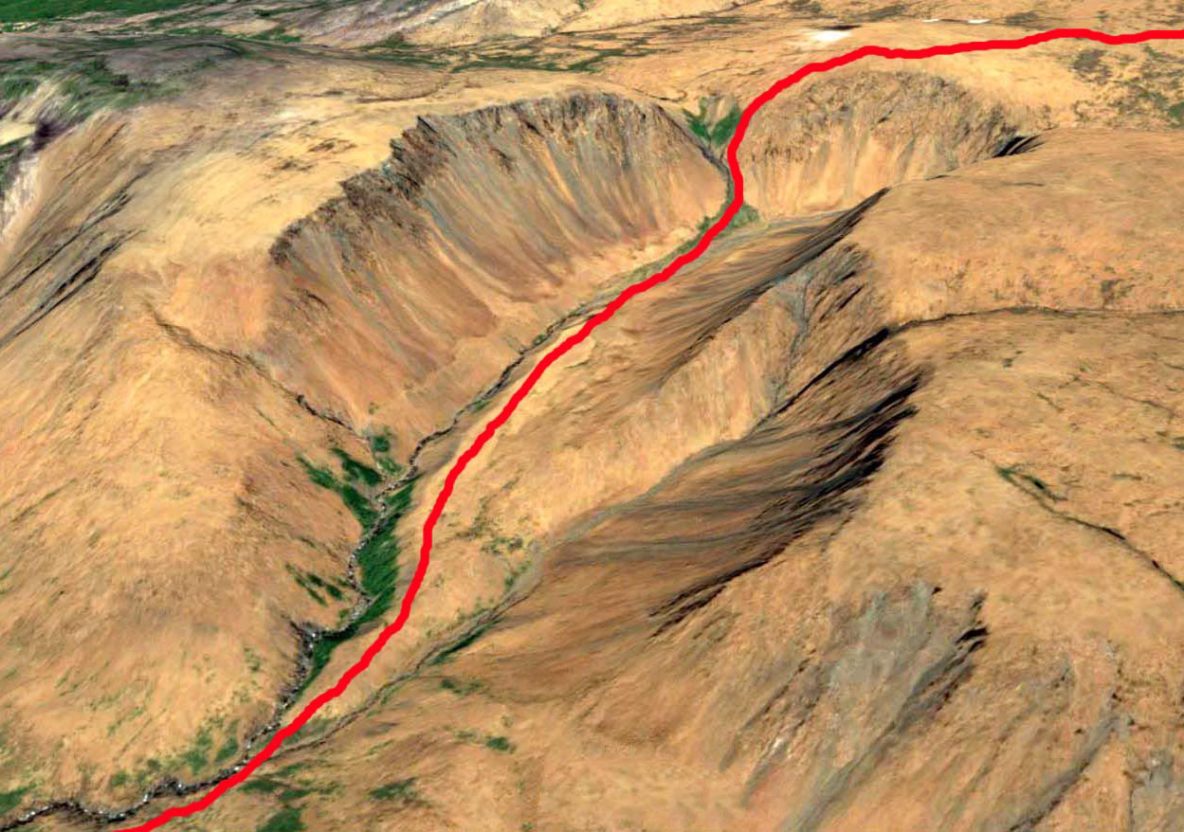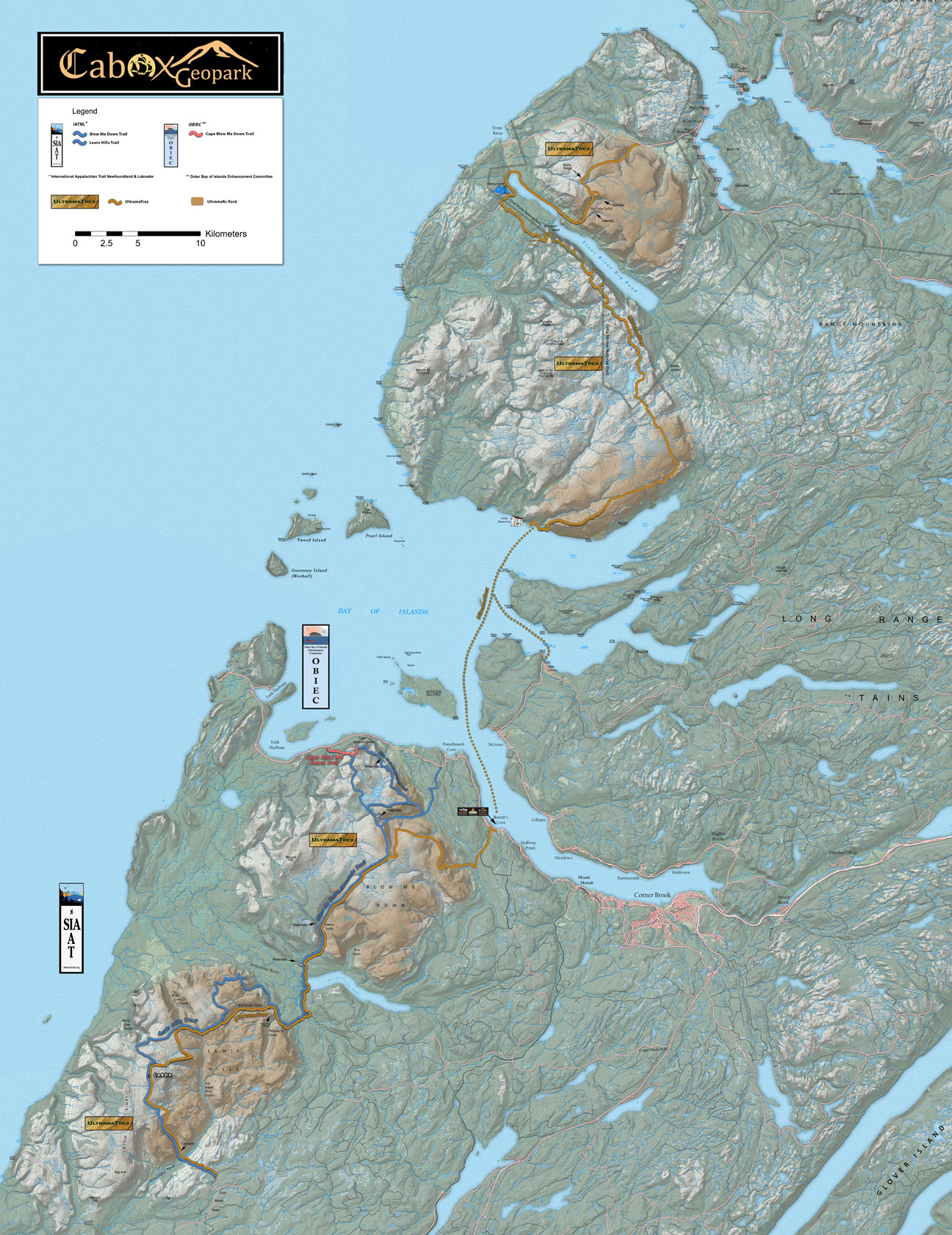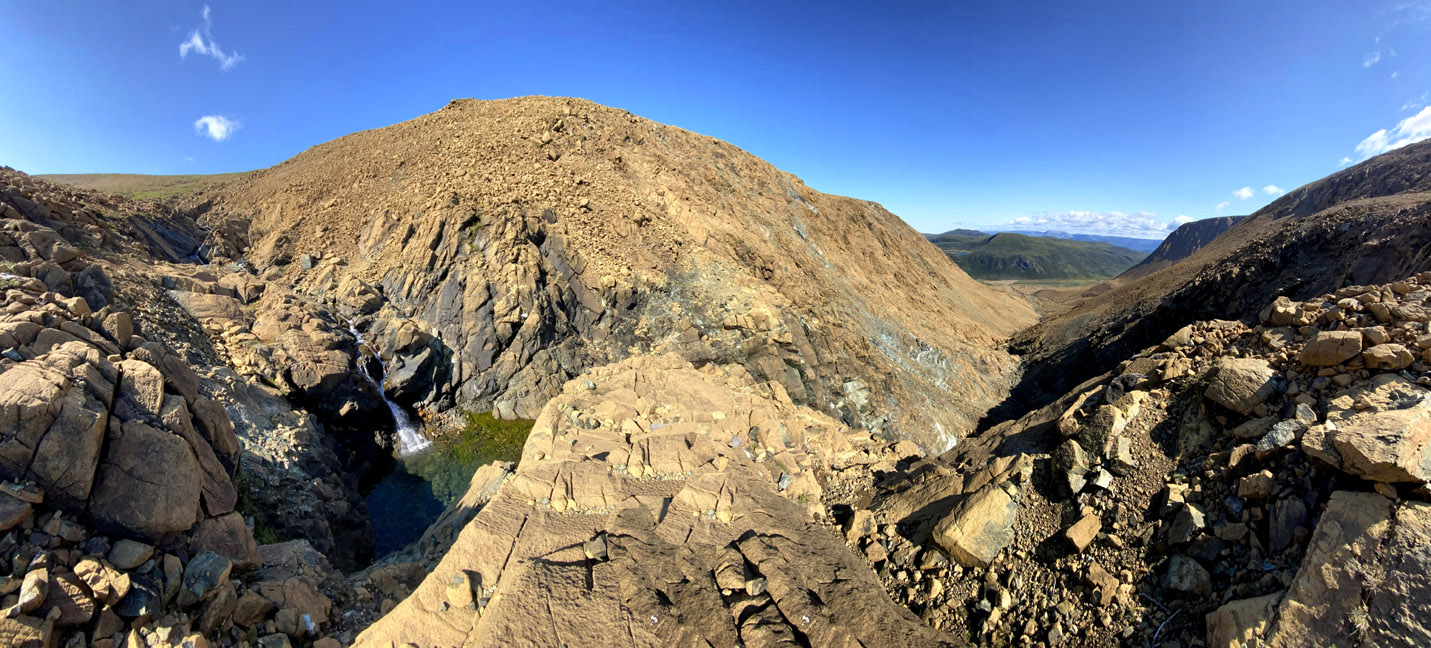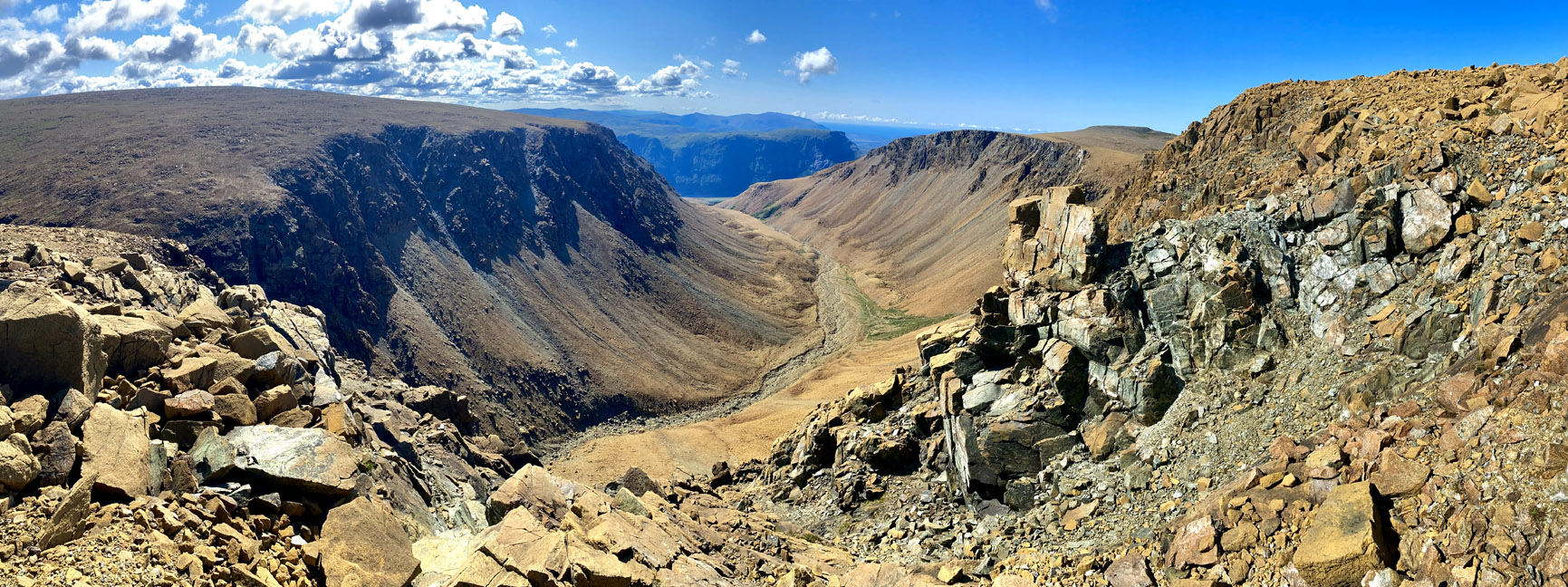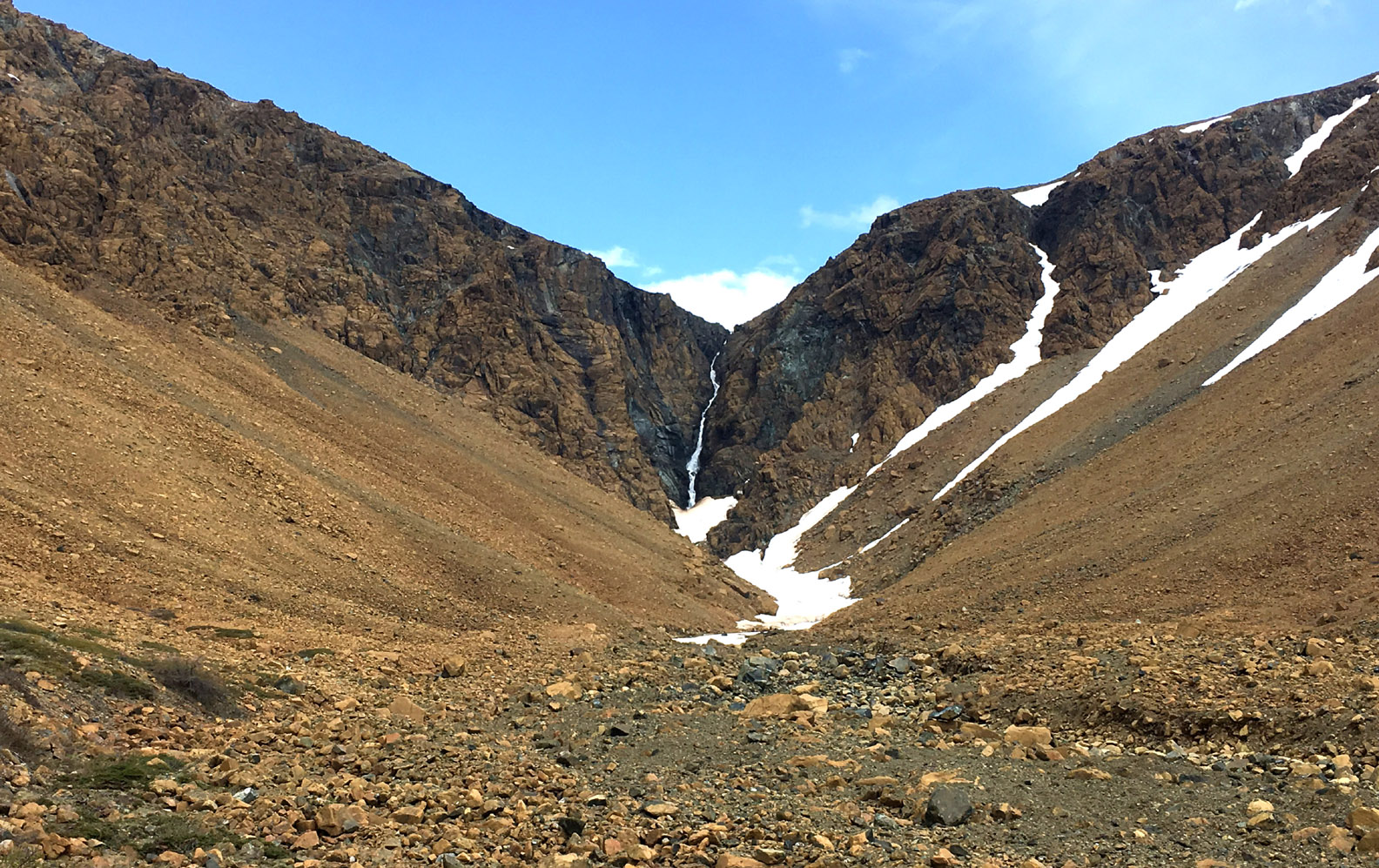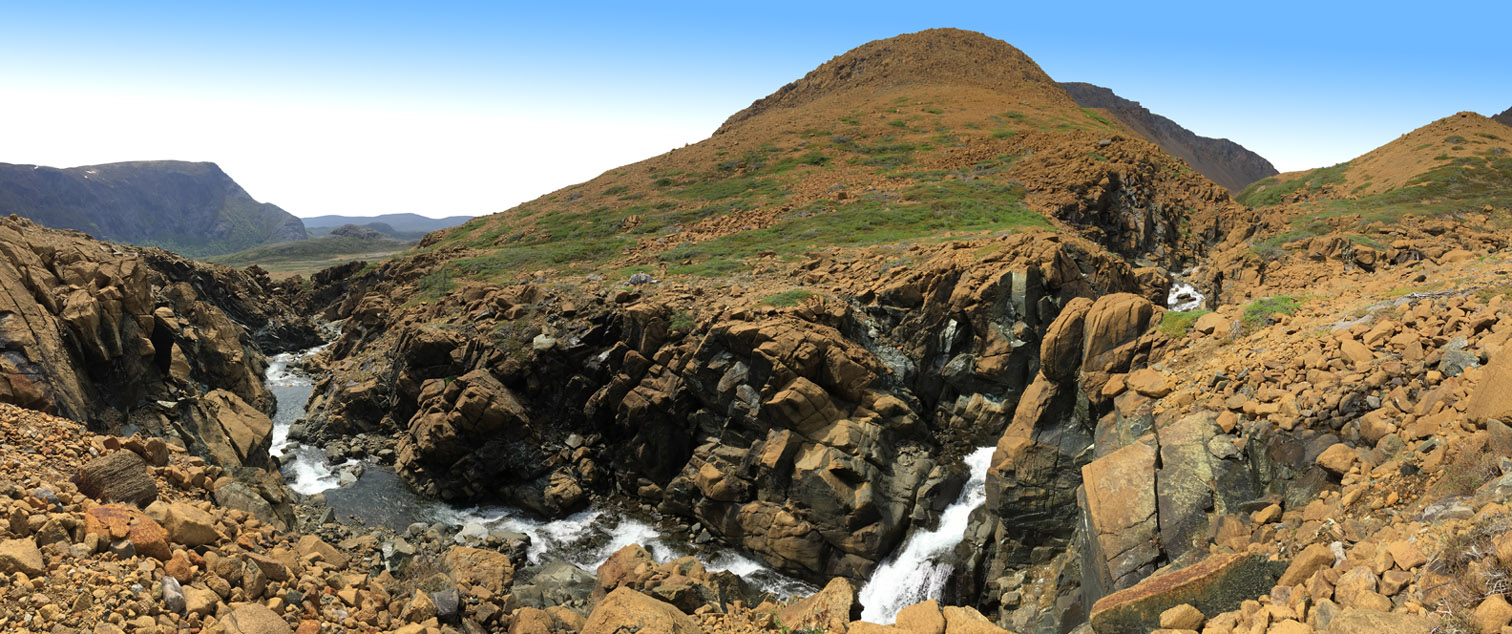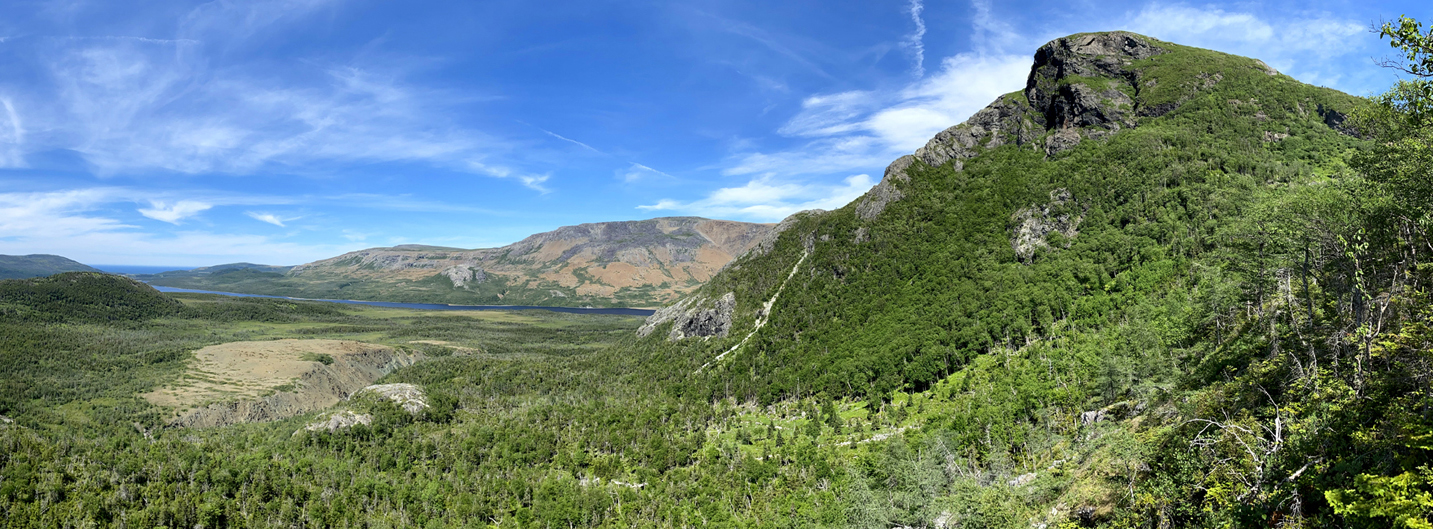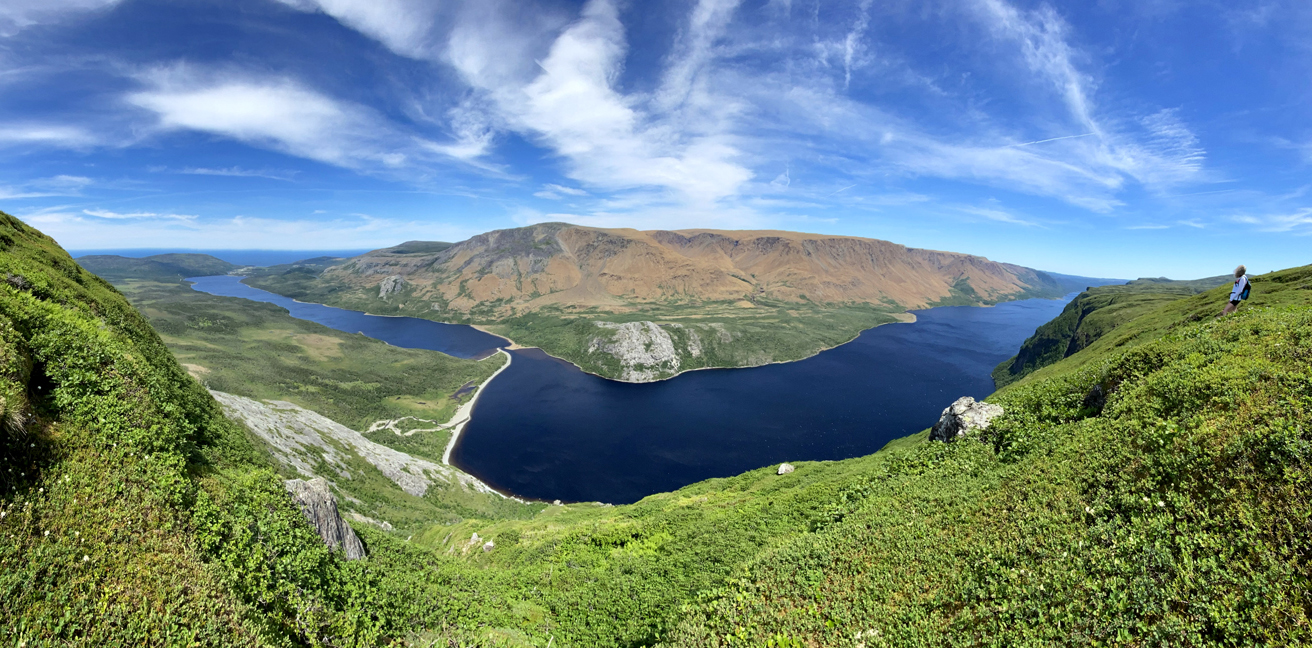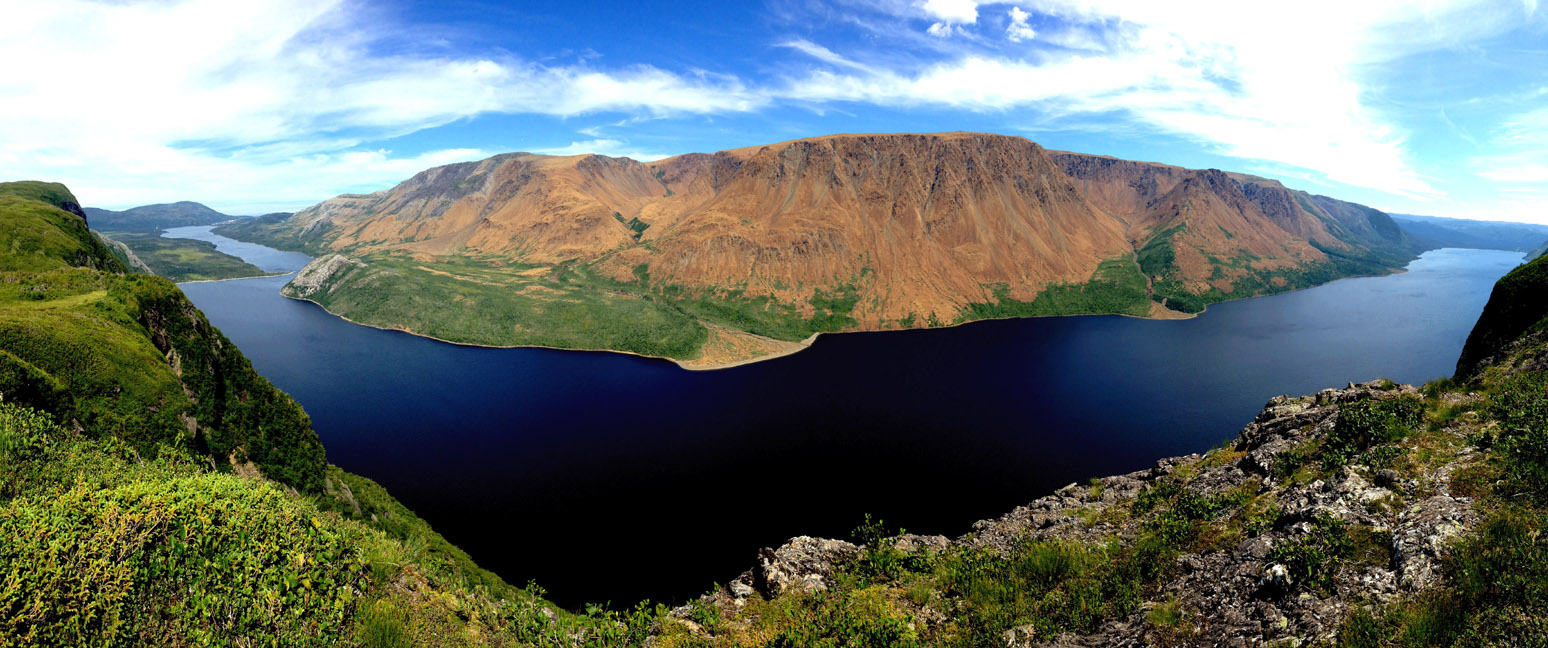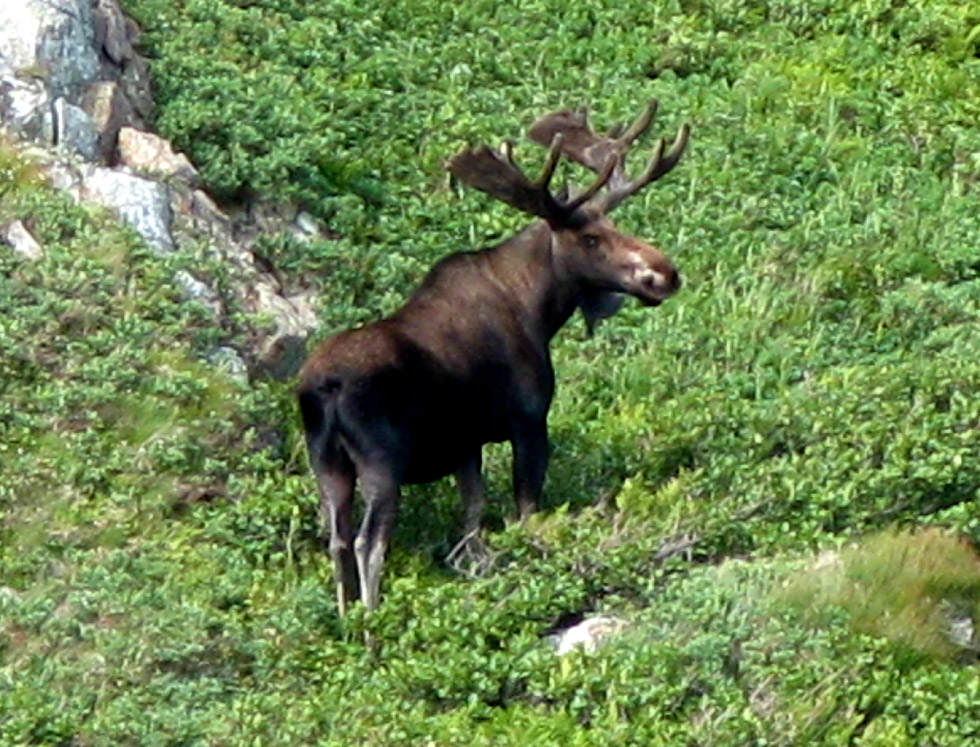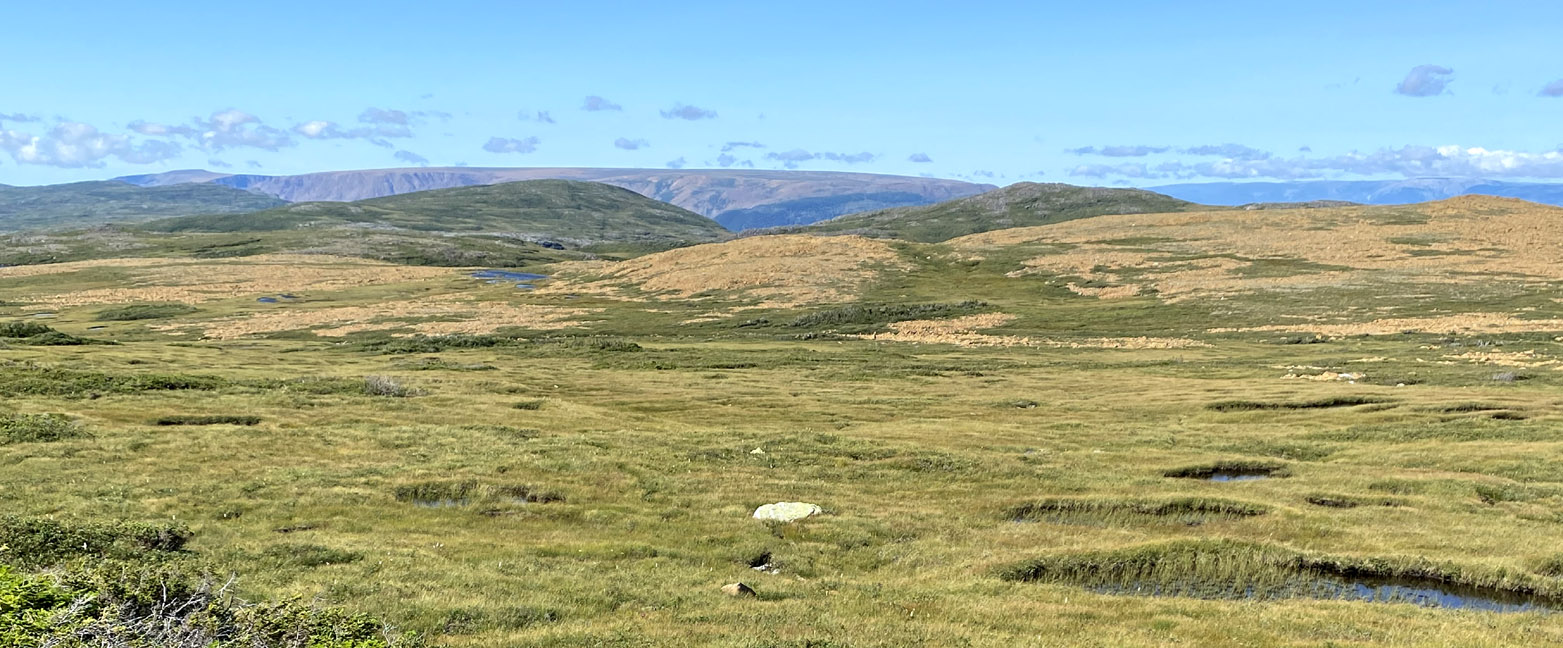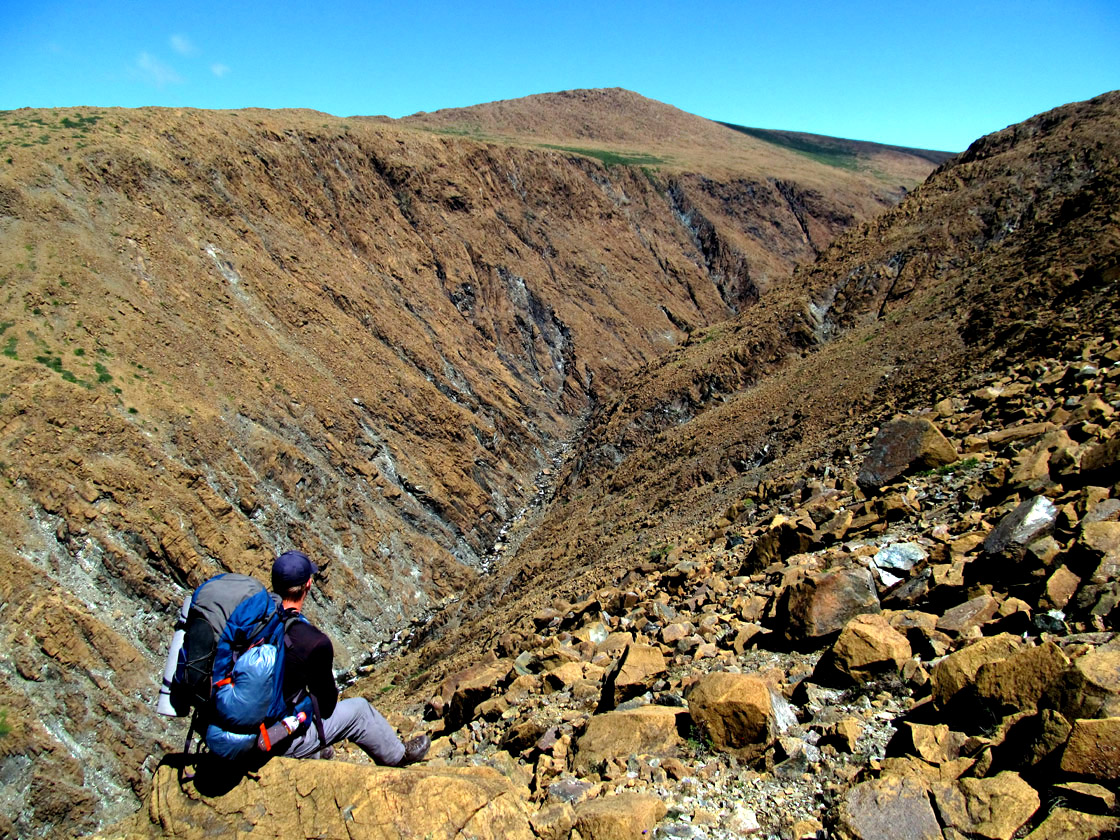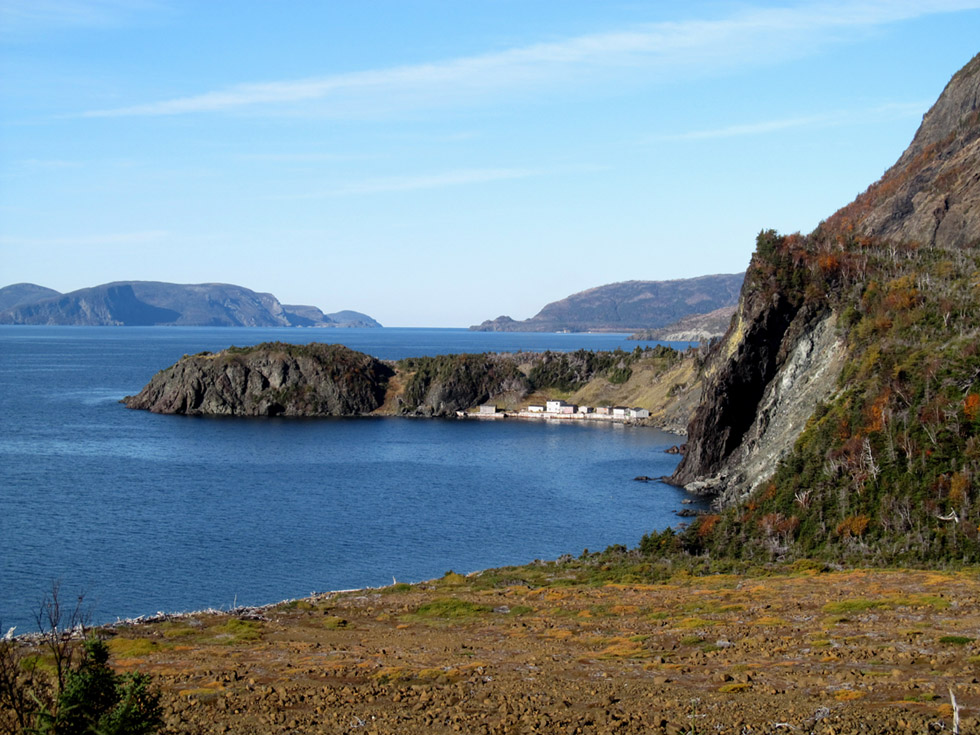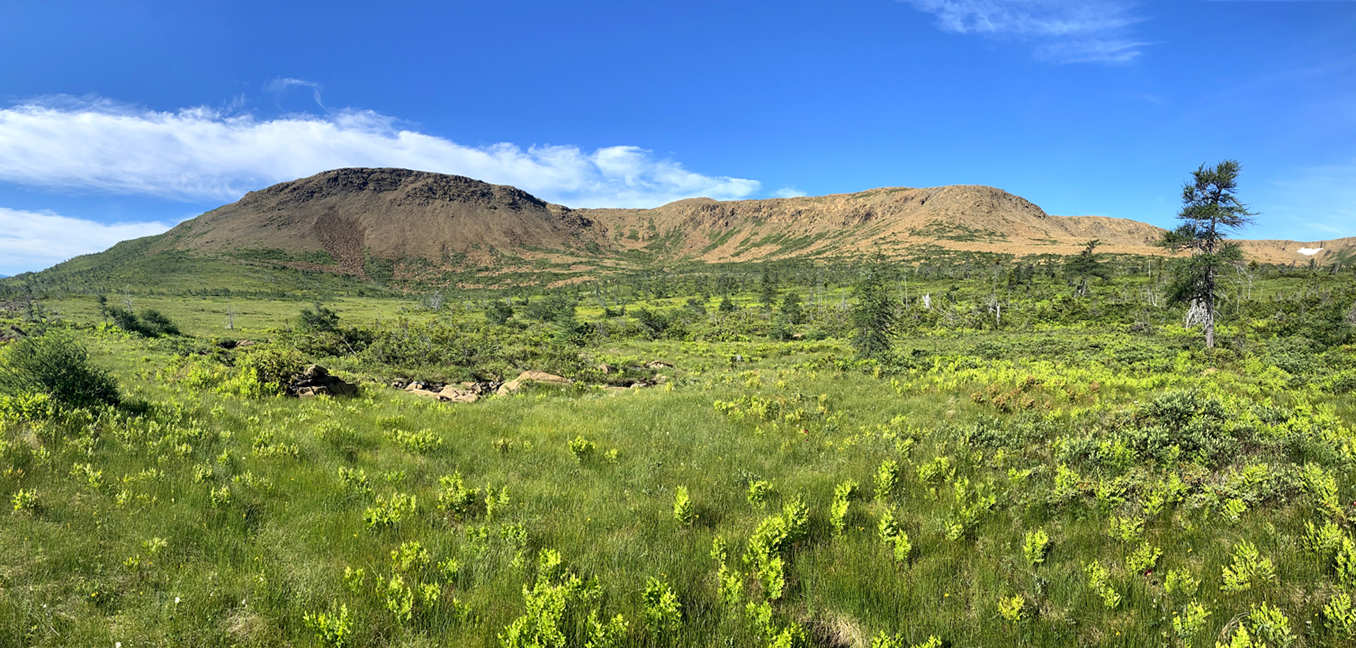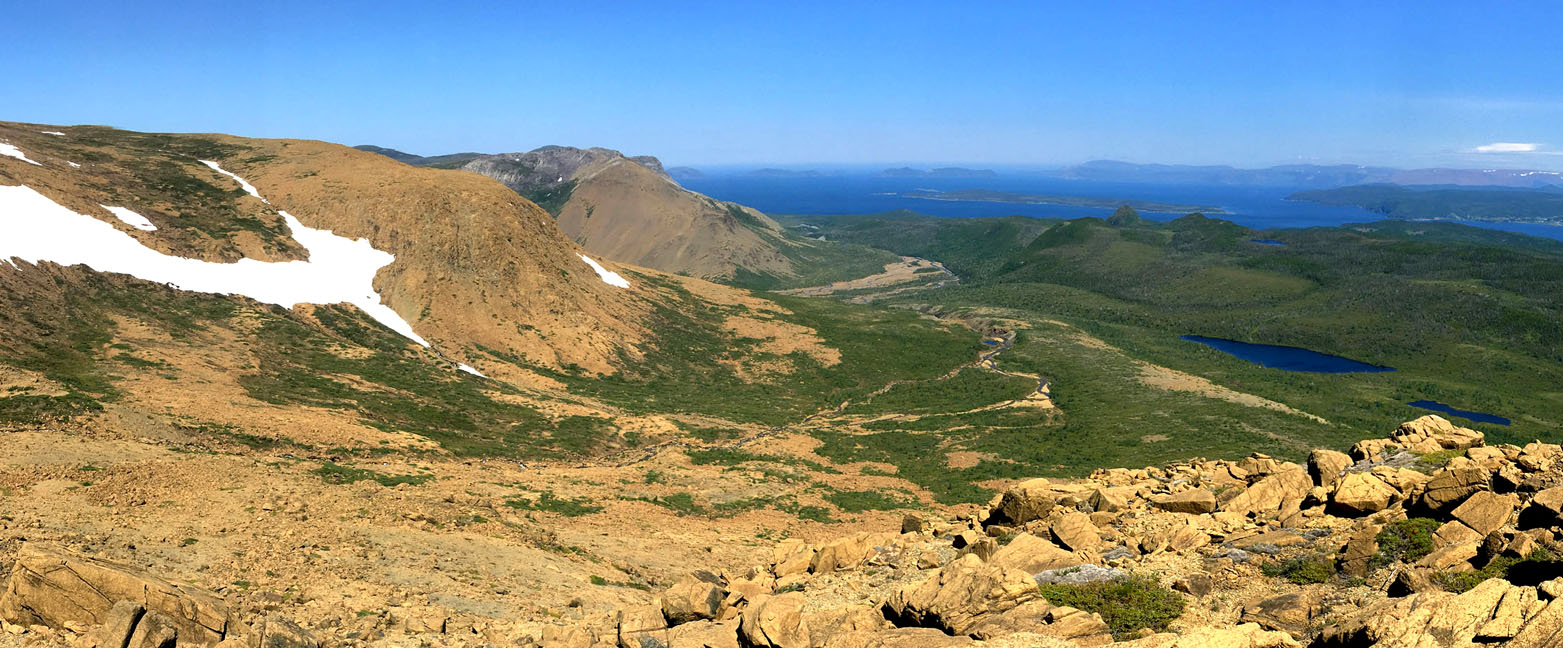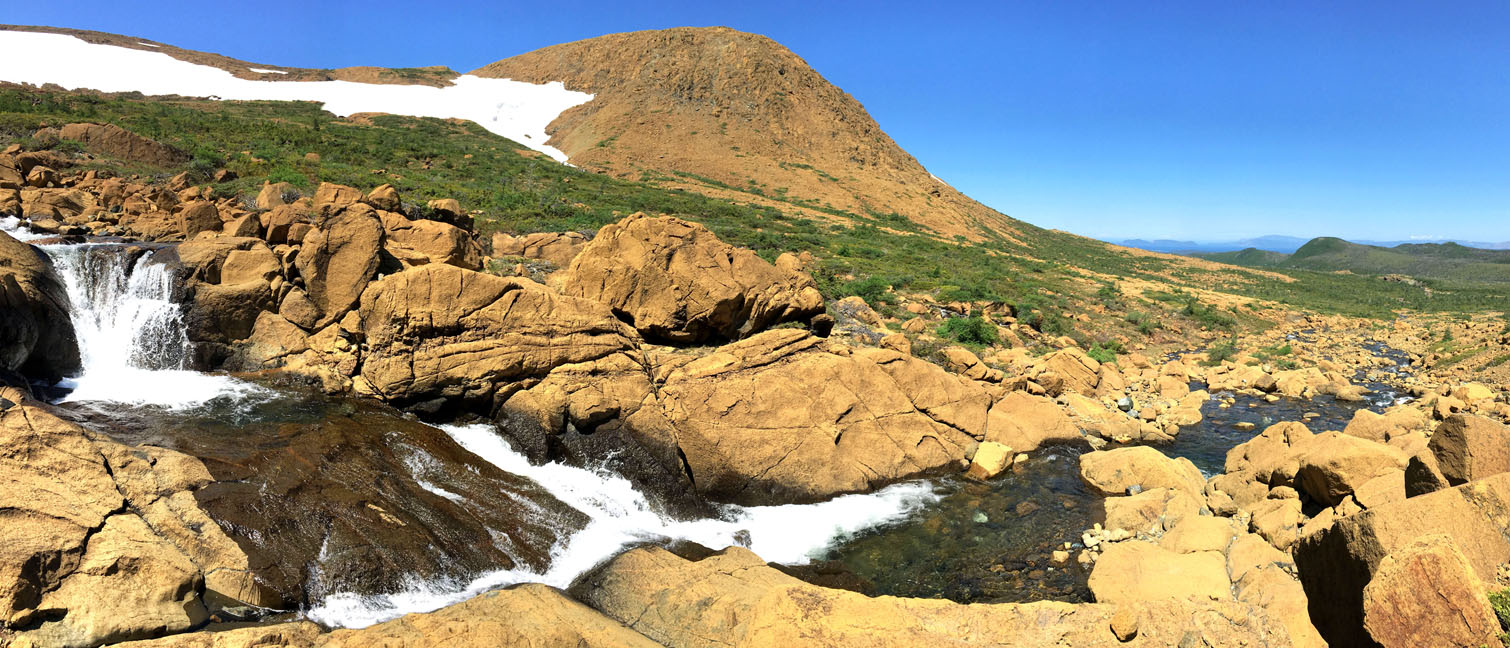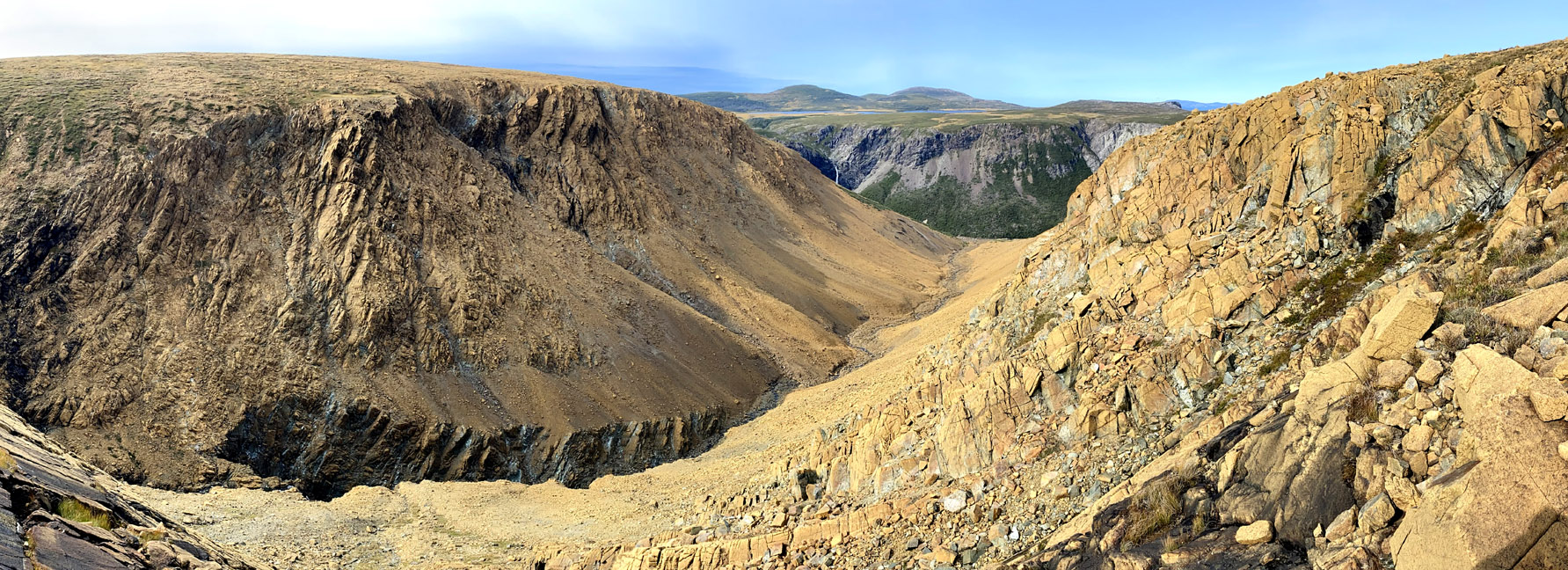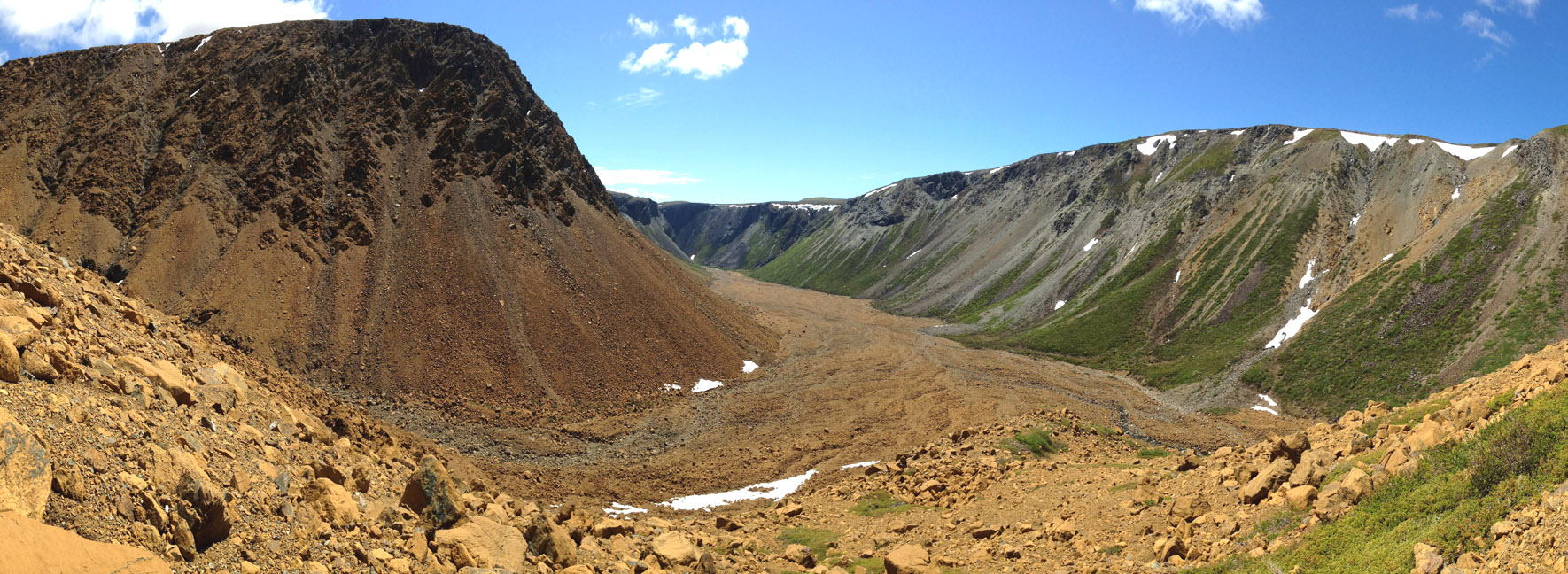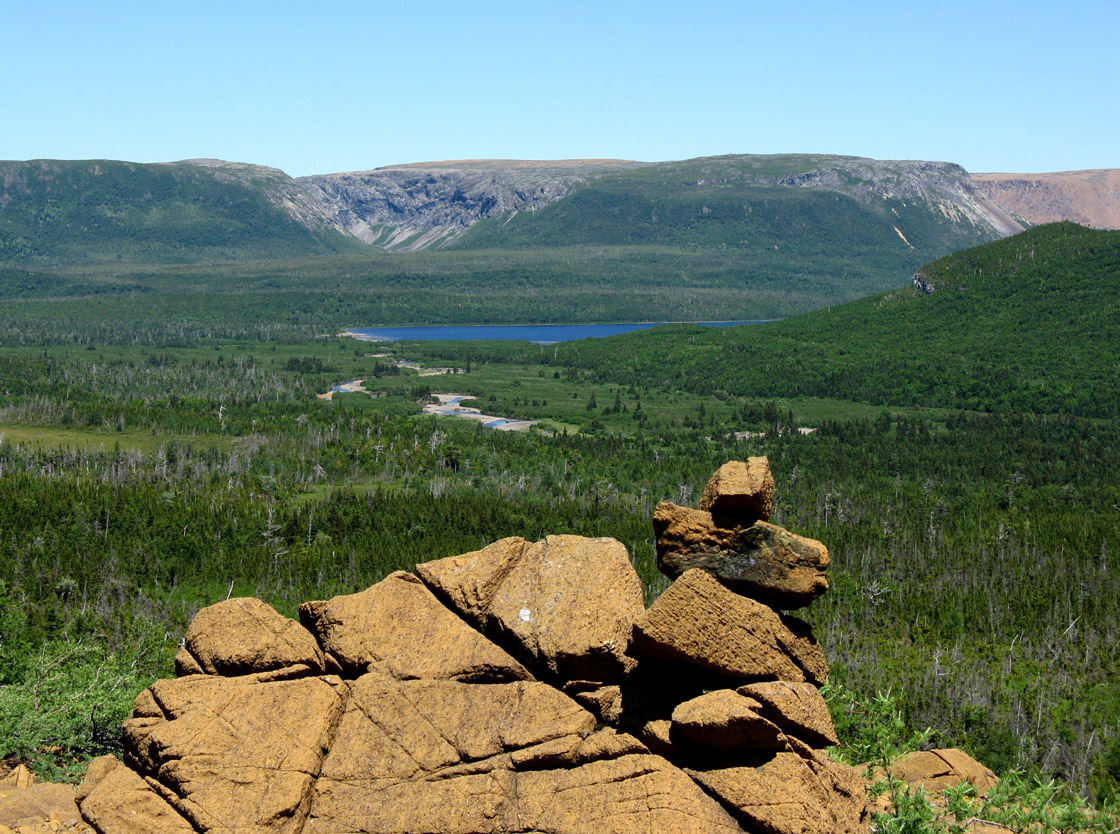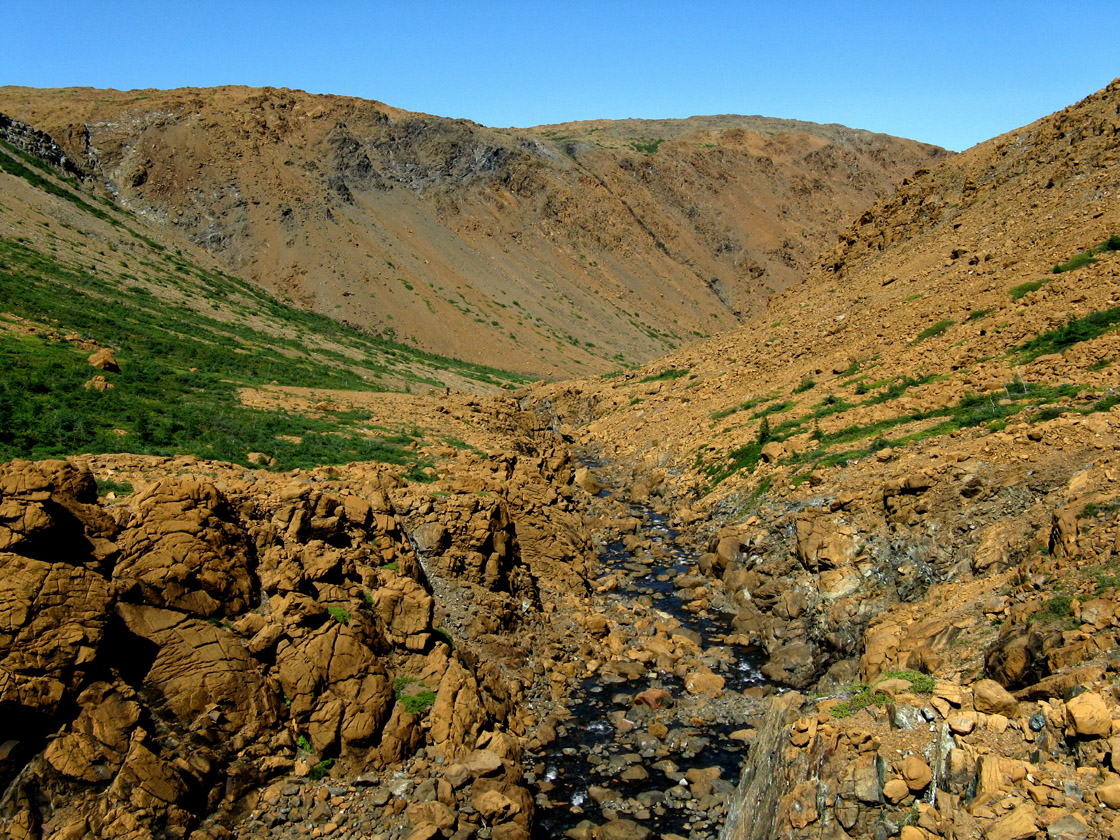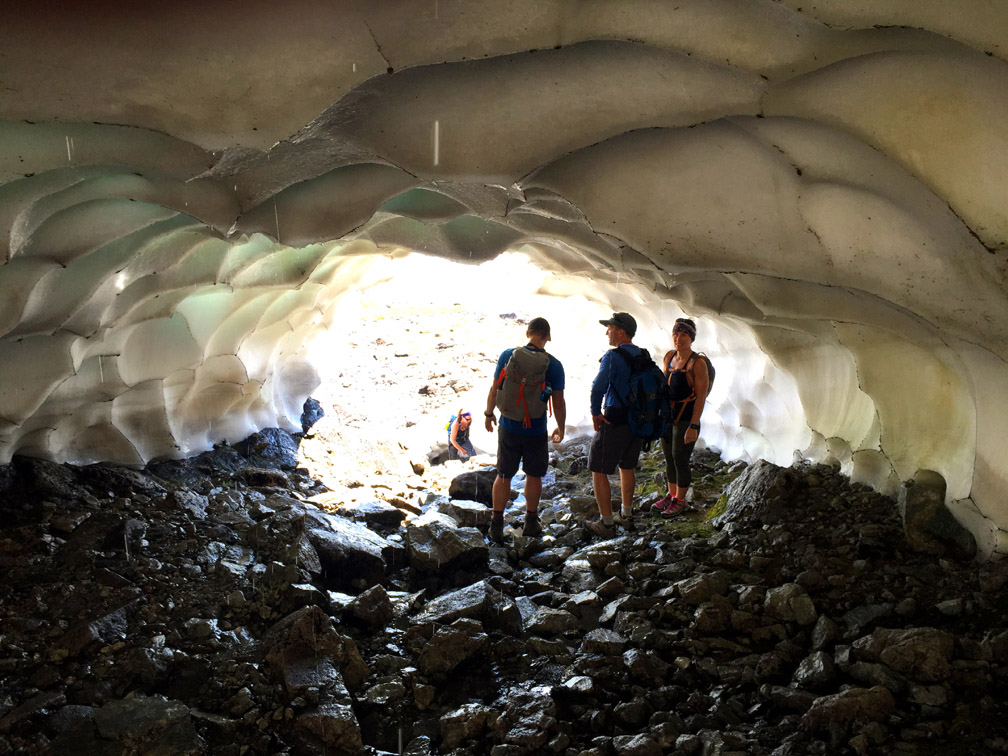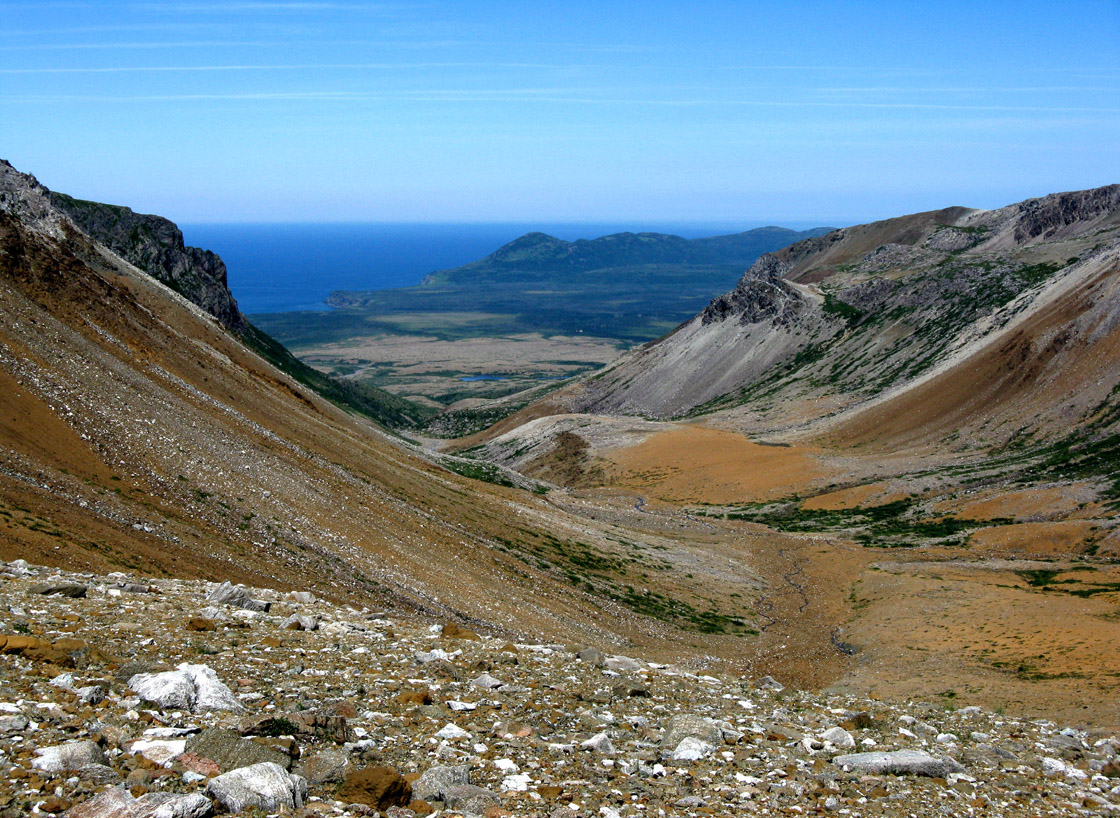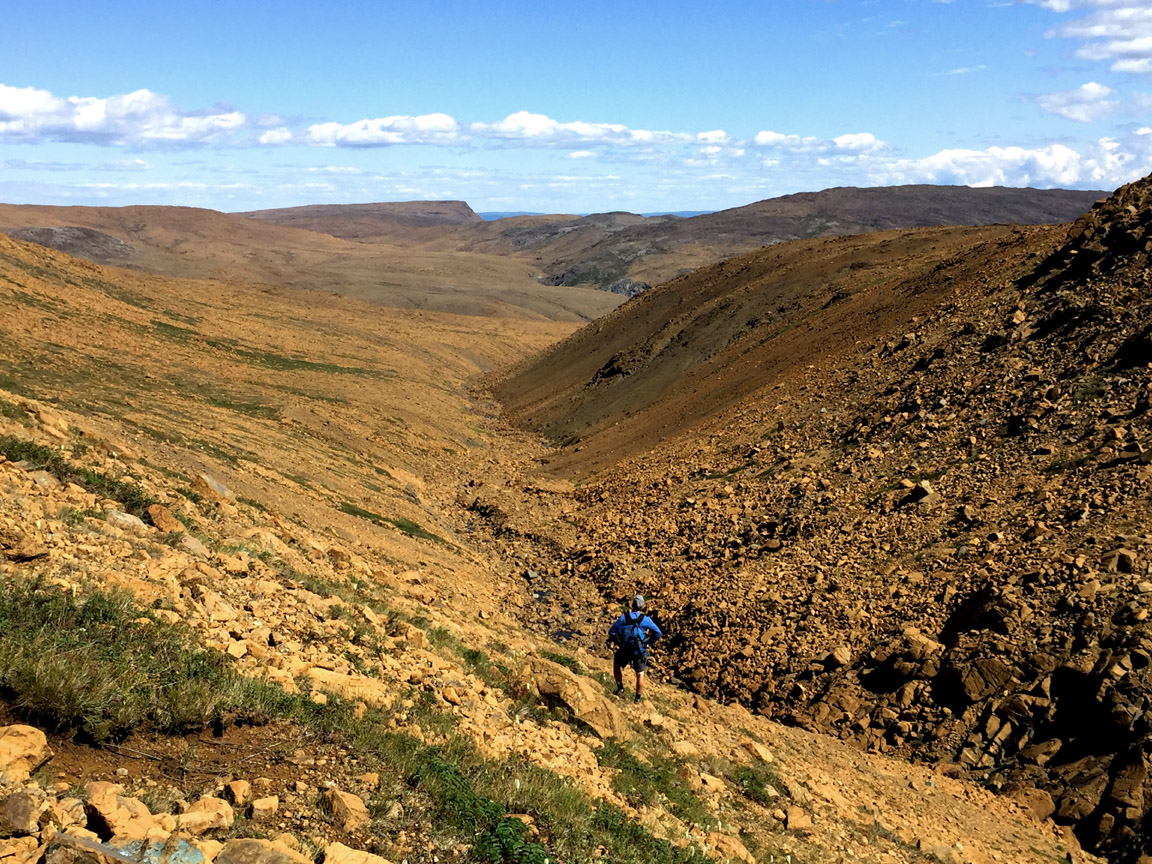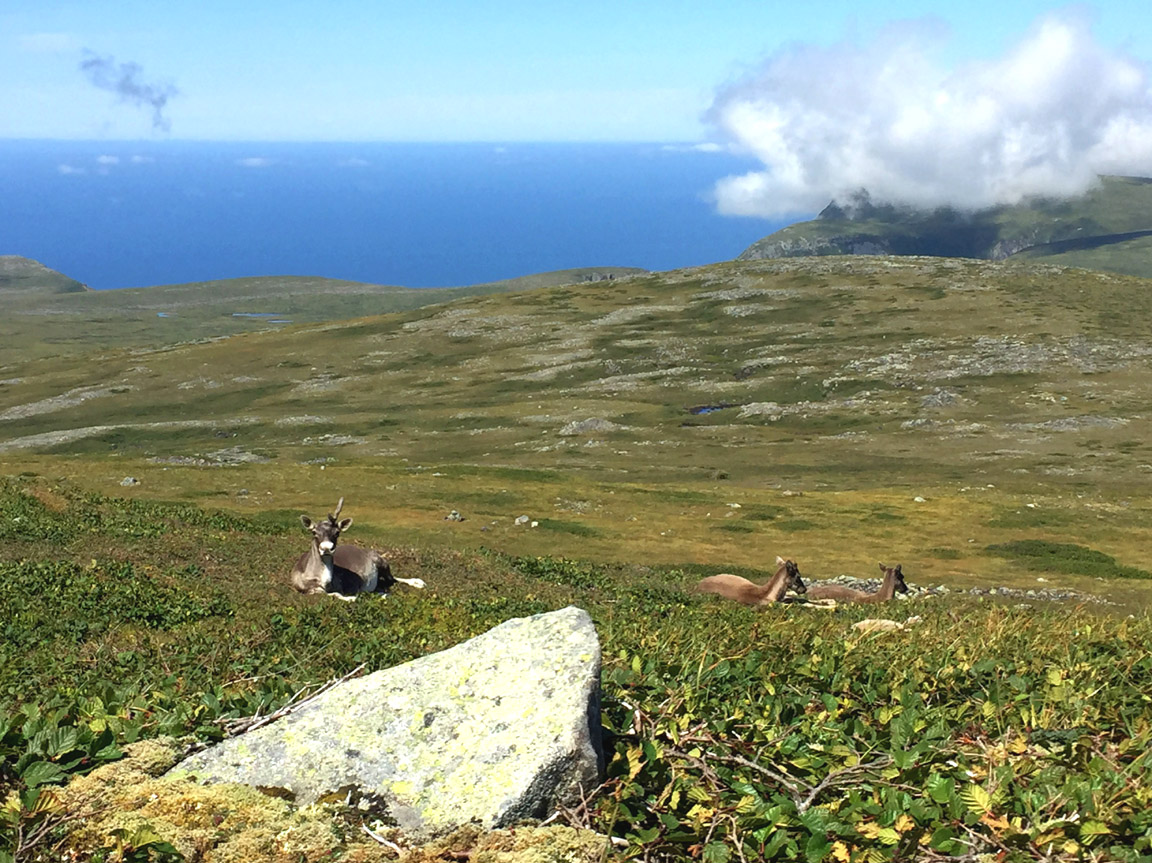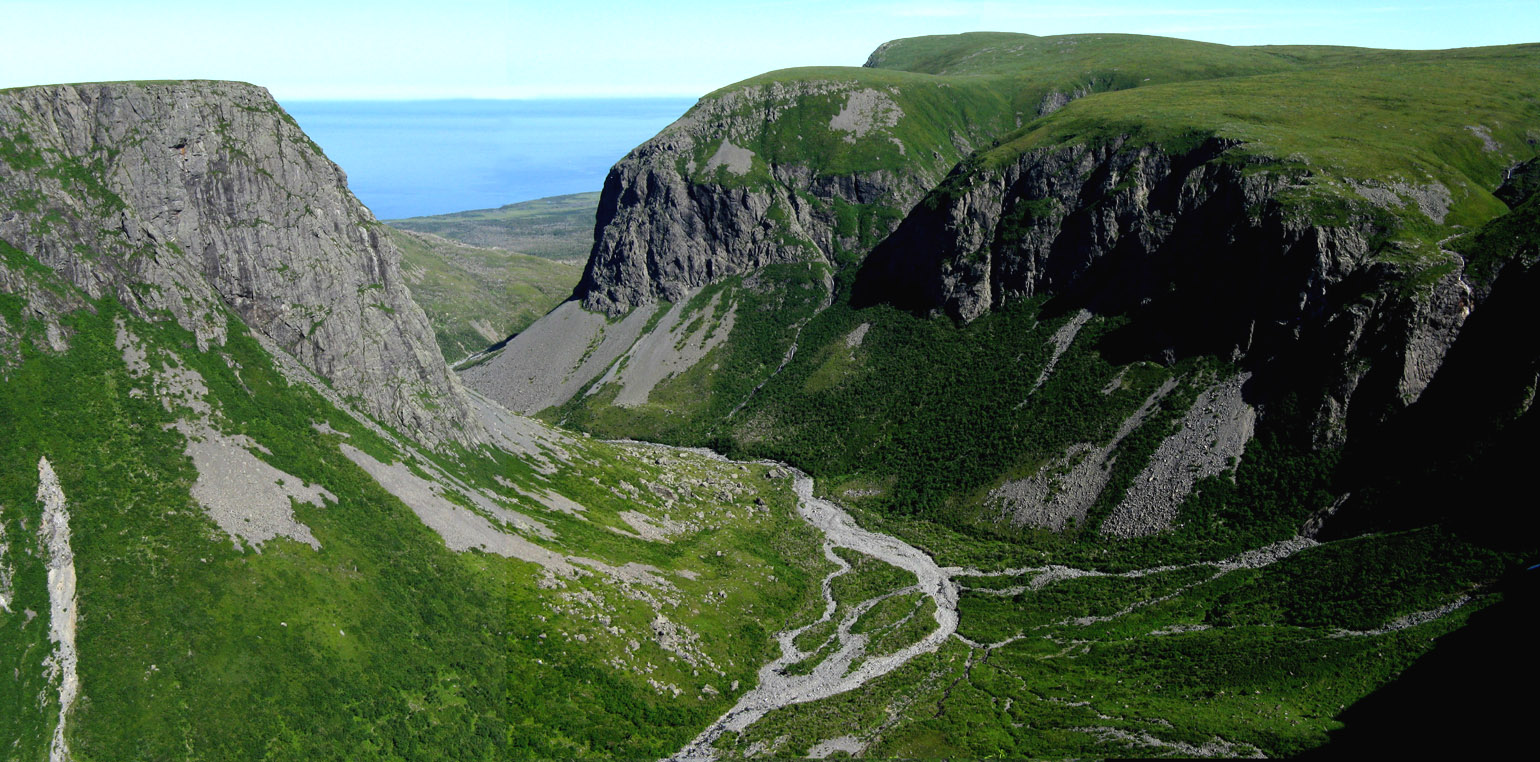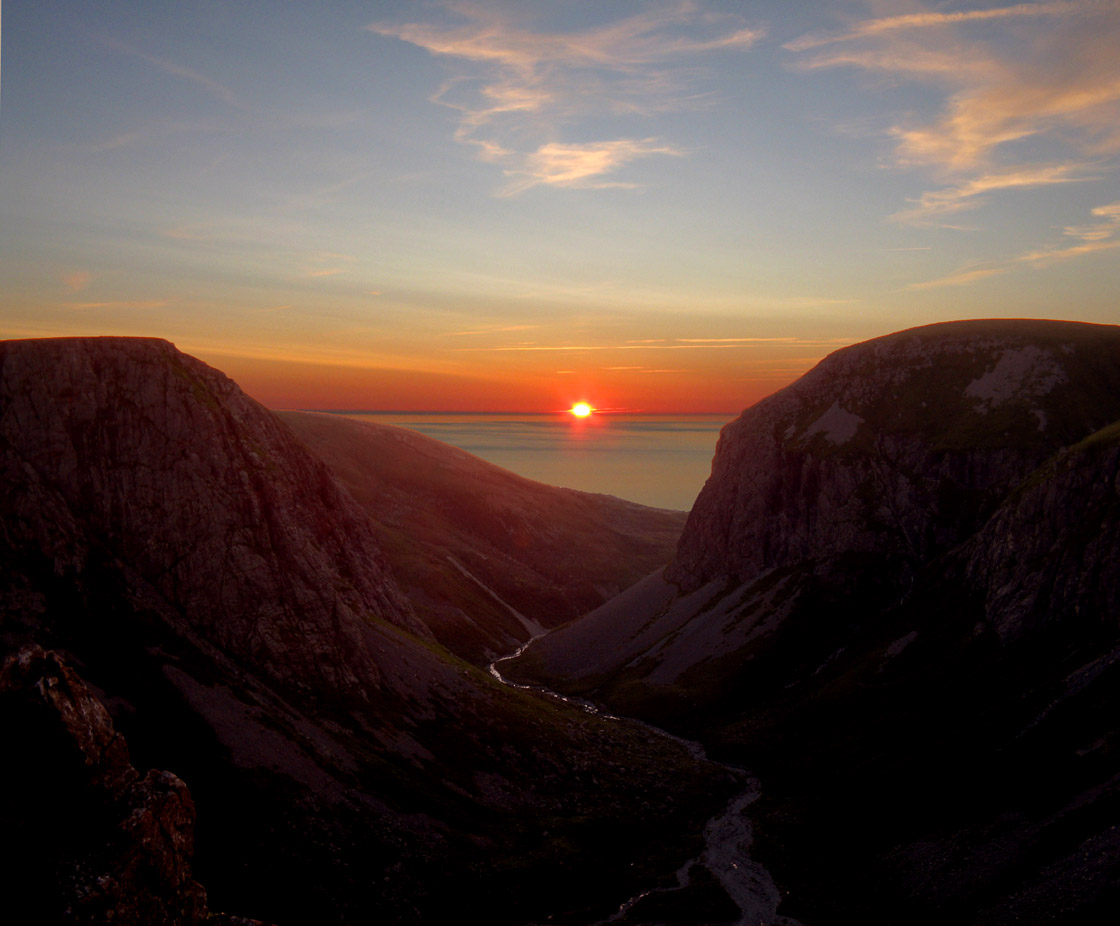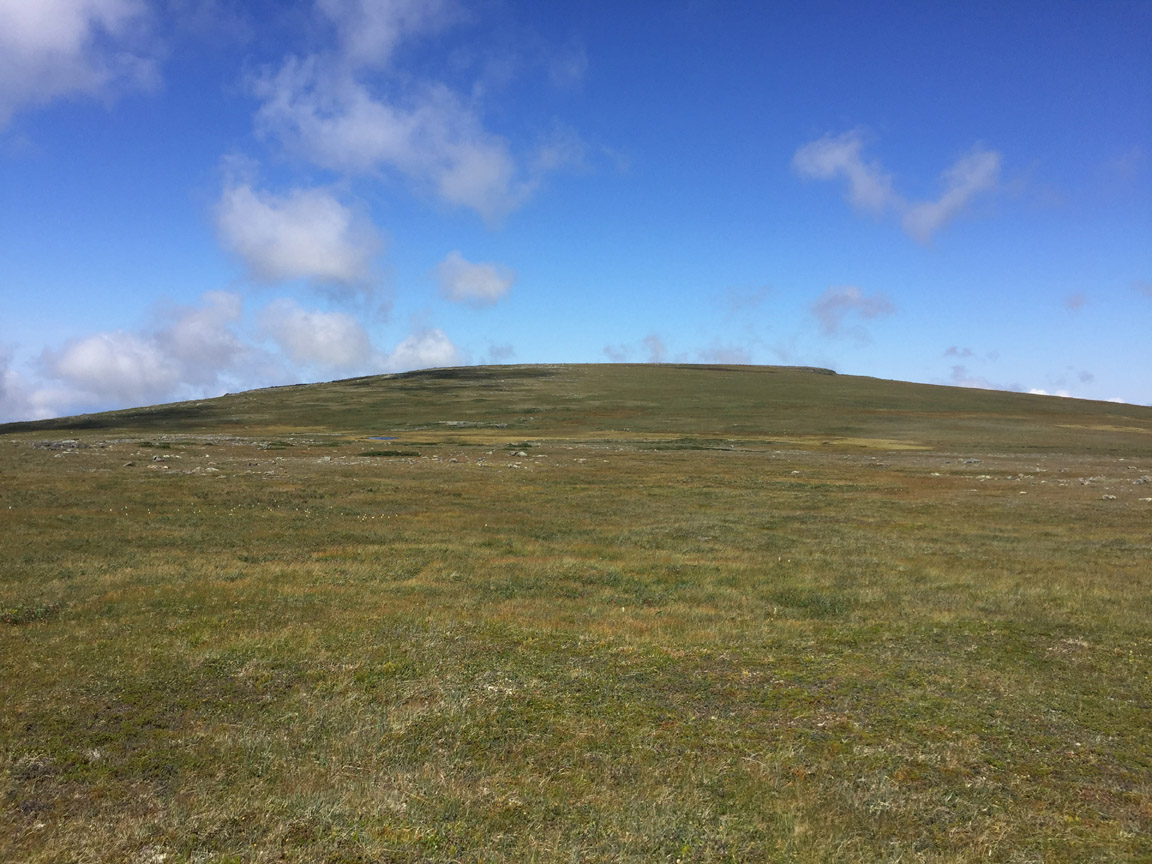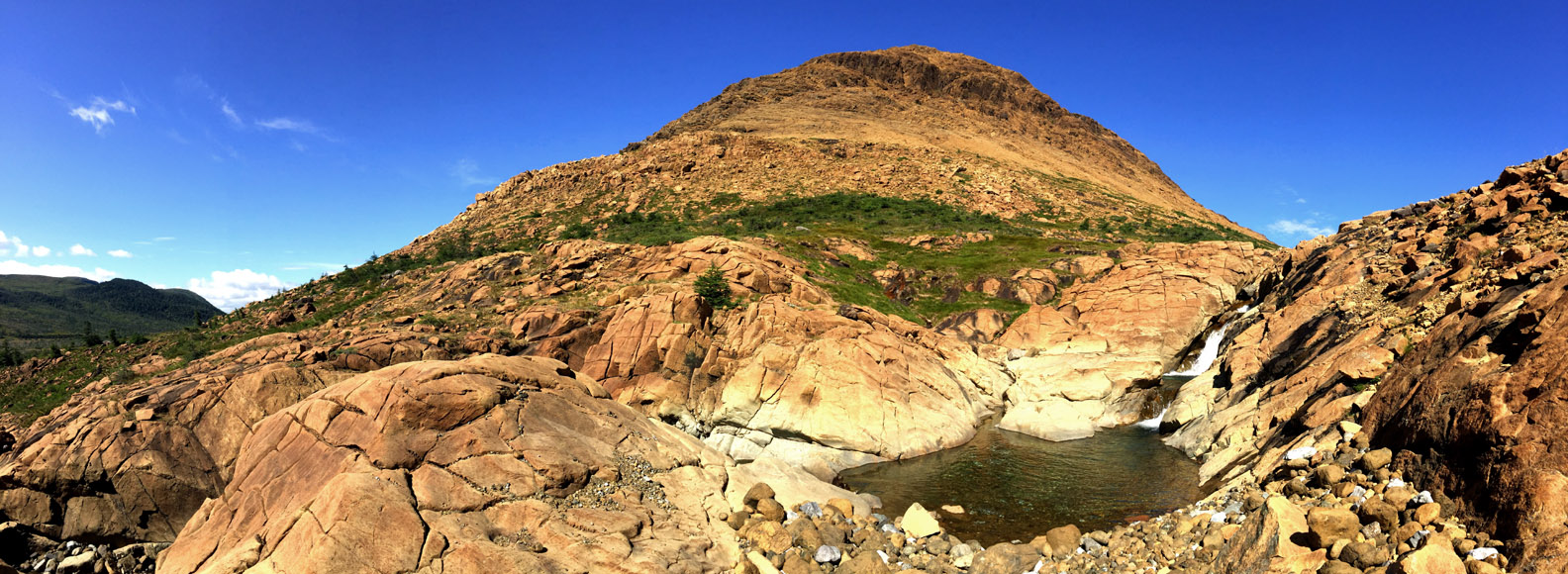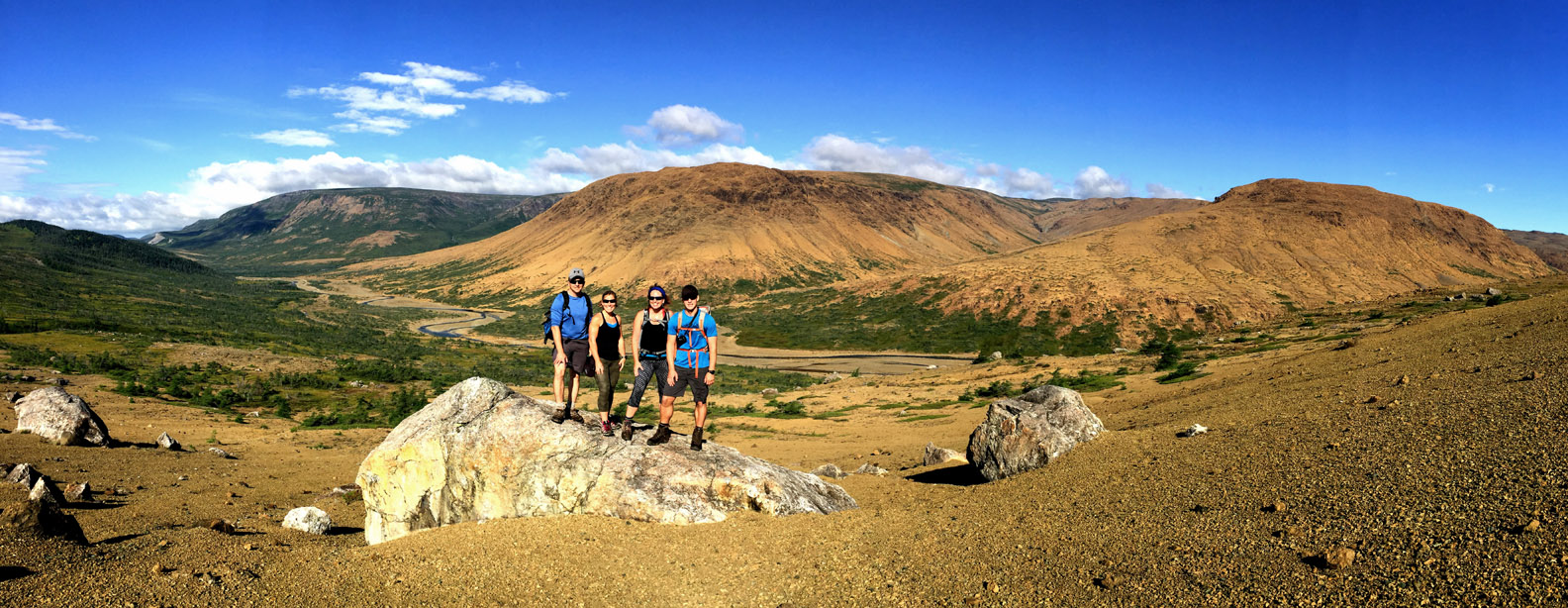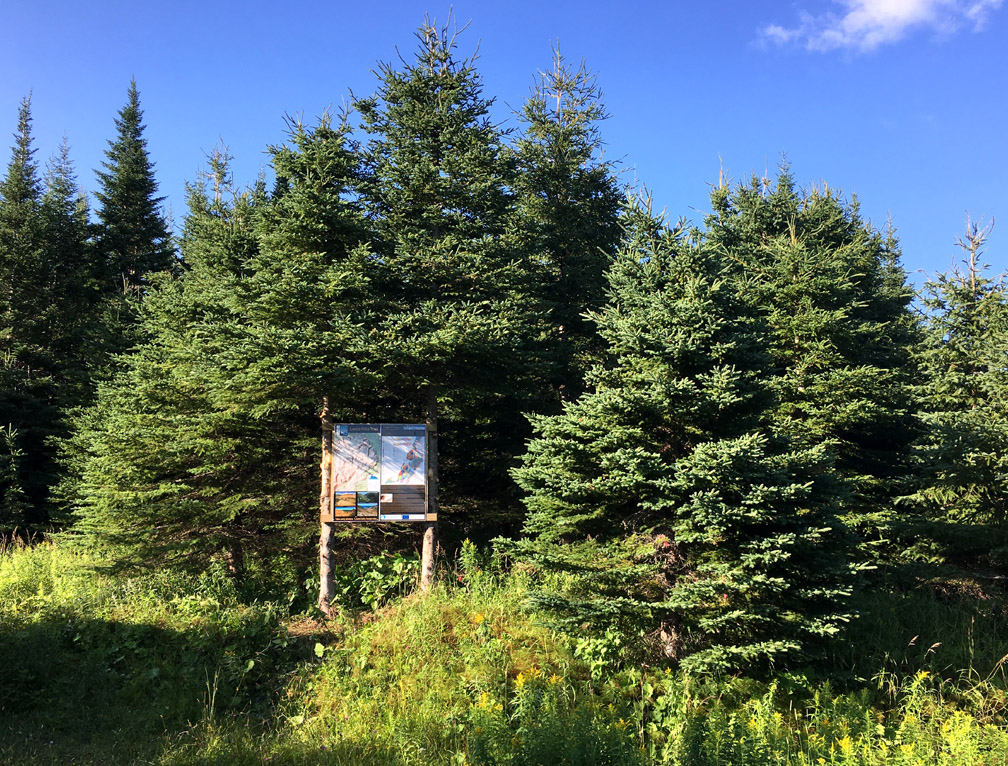The UltramaTrex is the trail route spine of Cabox Geopark which traverses the rust-colored “ultramafic” sections of the four Bay of Islands Ophiolite Massifs. It extends from the north side of Table Mountain (aka Tablelands) in Gros Morne National Park in the north to Fox Island River east of the Lewis Hills in the south. Between the two northern massifs (Table Mountain and North Arm) and the two southern massifs (Blow Me Down and Lewis Hills) is the Bay of Islands, which must be crossed by boat between Stowbridges (aka Stone Brook) and Benoit’s Cove, or between Stowbridges and Cox’s Cove, then by ground transportation to Benoit’s Cove.
The UltramaTrex is approximately 145 kilometers (90 miles) in length and is divided into four stages, one for each of the four ophiolites. The stages can be completed individually, in pairs (northern and southern), or together as a single trek. In total, the UltramaTrex requires 6 – 8 days to complete.
Stage One – Table Mountain Massif – is approximately 18 kilometers (10.8 miles) in length and can be completed in approximately 9 hours, 9.5 hours to the Trout River Pond campground. From the start at 150 meters (492 feet) above sea level at the entrance to the forked “gulch” west of Winterhouse Brook, the trek climbs up through the west branch of an ultramafic canyon composed primarily of oxidized peridotite from the earth’s mantle that was carried to the surface by tectonic forces during the closing of the Iapetus Ocean approximately 450 million years ago.
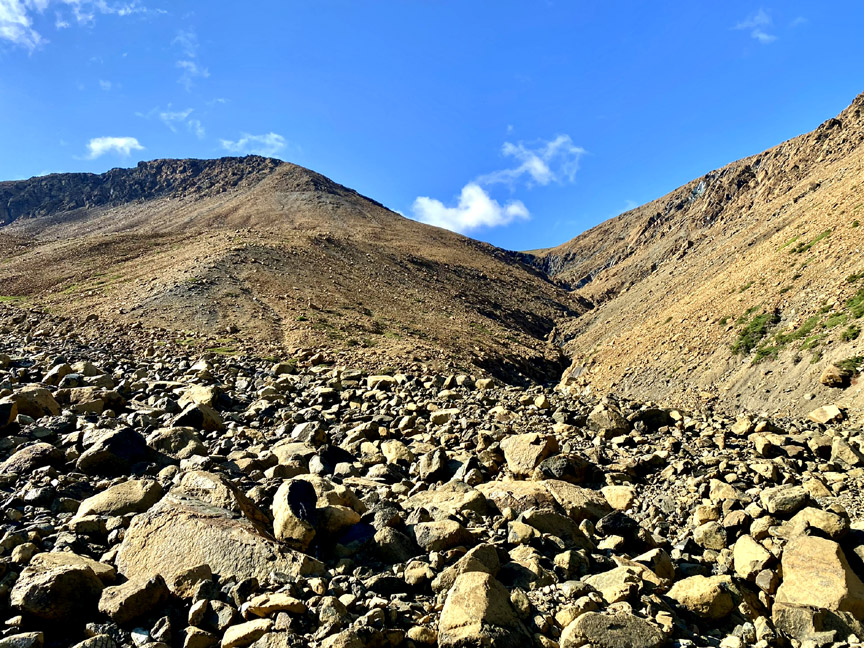
At 400 meters (1,312ft), hikers are rewarded with a nice panoramic view north through the gulch and south along its west wall to a 30 meter (100ft) waterfalls that spills out of the upper valley
where at 480 meters (1,575ft) the steeper incline levels off and a series of crystal-clear waterfalls provides hikers with a good opportunity for a cool dip on a hot summer day.
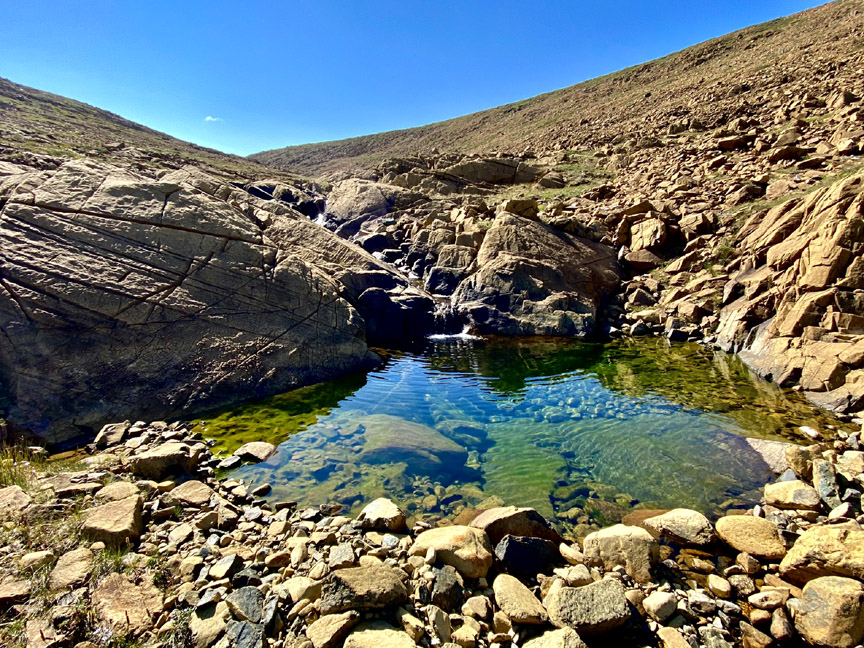
The upper valley is composed almost exclusively of peridotite, with little patches of grass and moss and the occasional wildflower taking advantage of every opportunity
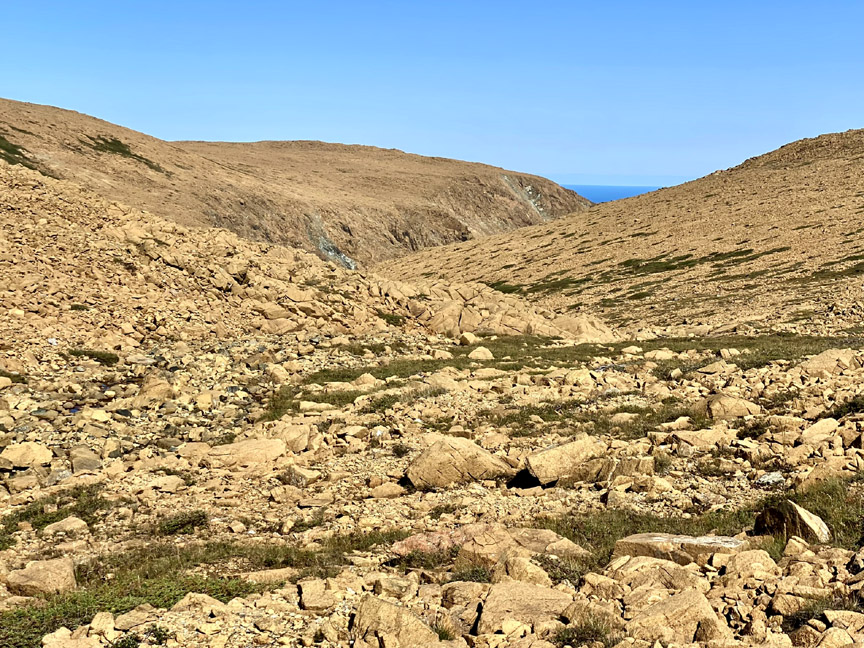
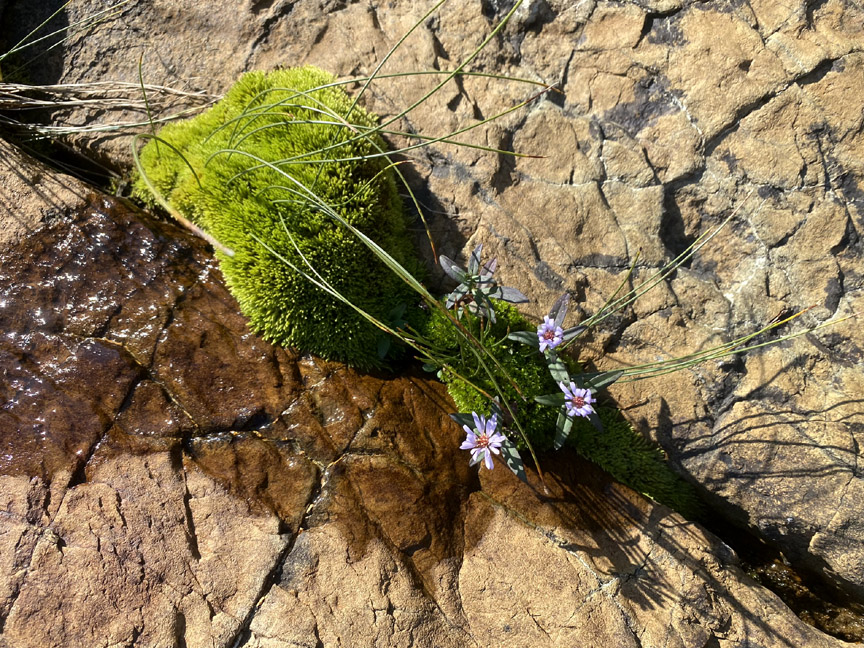
A short climb west out of the valley leads to big sky country and expansive peridotite barrens
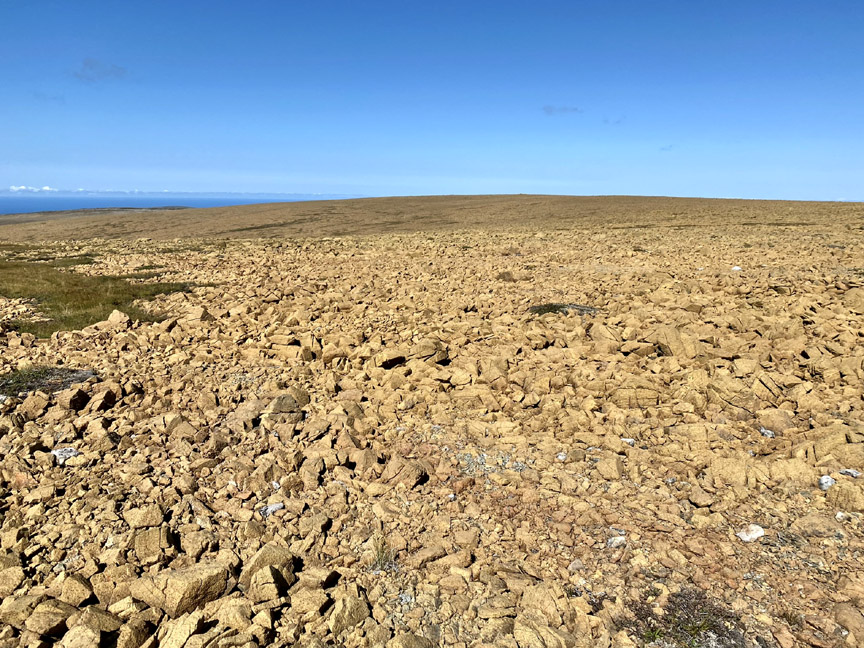
followed by a 2km gradual descent to Moho Ridge, where rust-colored periditote from the earth’s mantle collides with light-gray gabbro from the ocean floor above, in a geological pas de deux nearly 500 million years old.
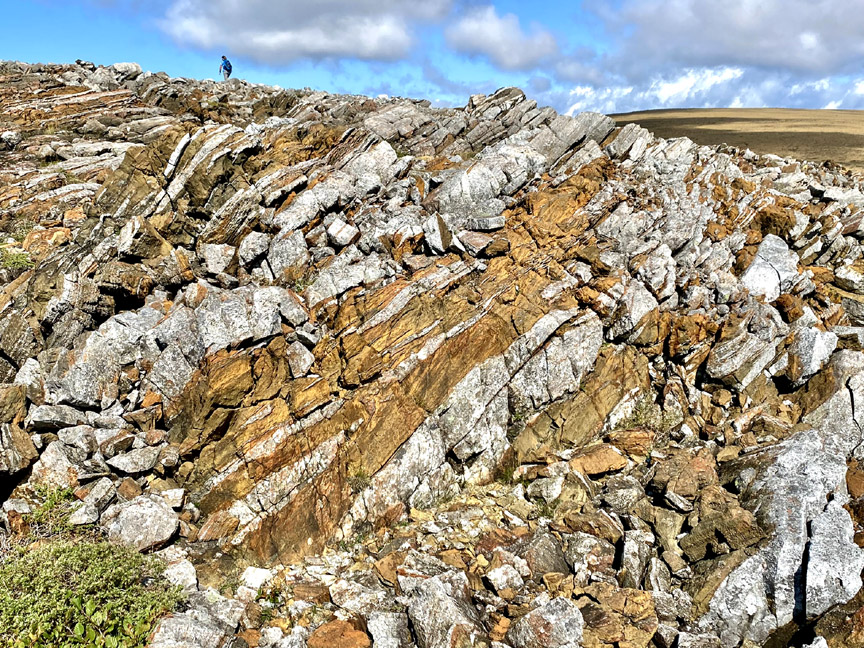
The Moho, or Mohorovičić discontinuity, is the boundary between earth’s crust and mantle and is defined by the distinct change in velocity of seismic waves as they pass through changing densities of rock. It is typically found 5 to 10 kilometres (3–6 miles) below the ocean floor, and 20 to 90 kilometres (10–60 mi) beneath continental crusts, and is identified on earth’s surface by alternating bands of peridotite and gabbro.
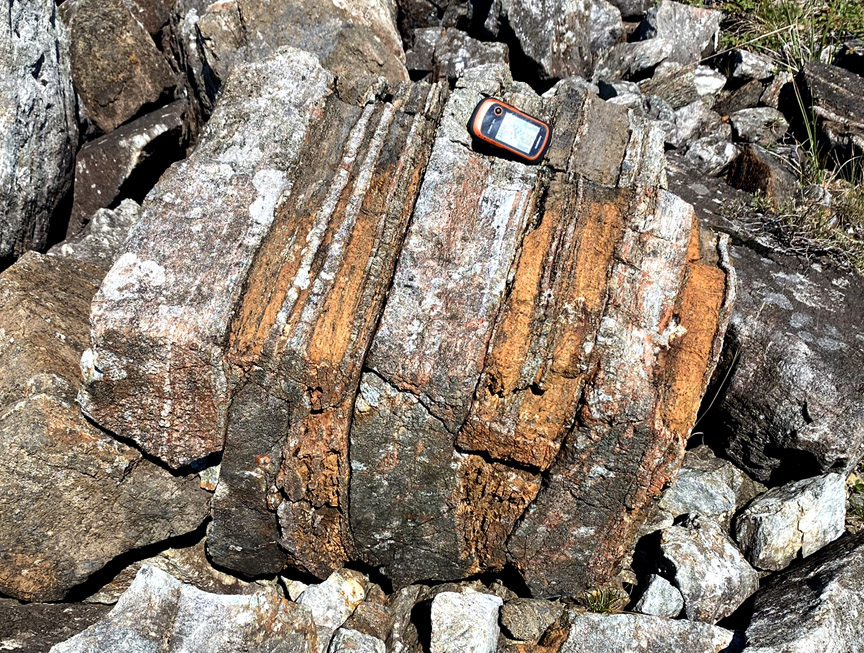
From Moho Ridge, hikers must traverse a 1km-wide valley to the back end of Fox Point Gulch.
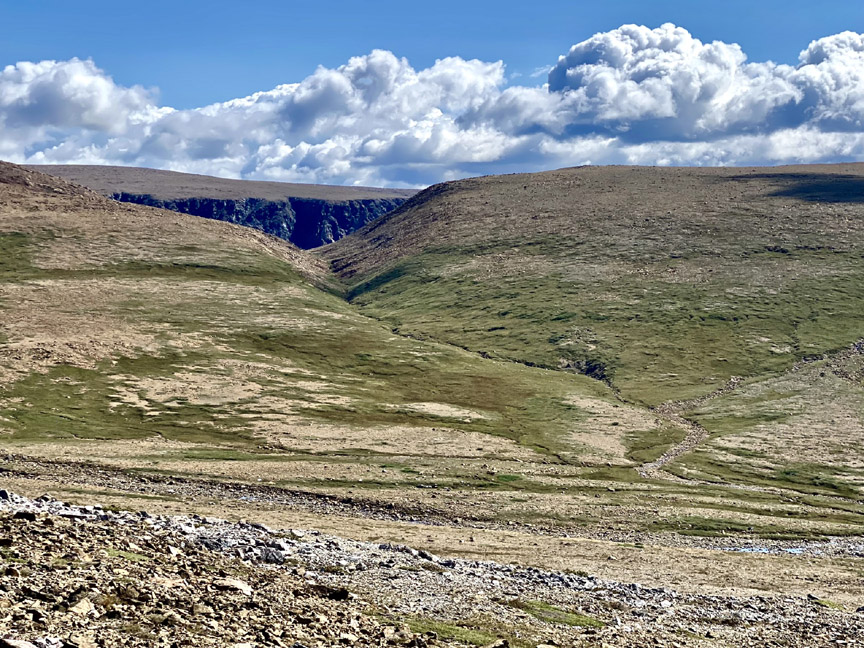
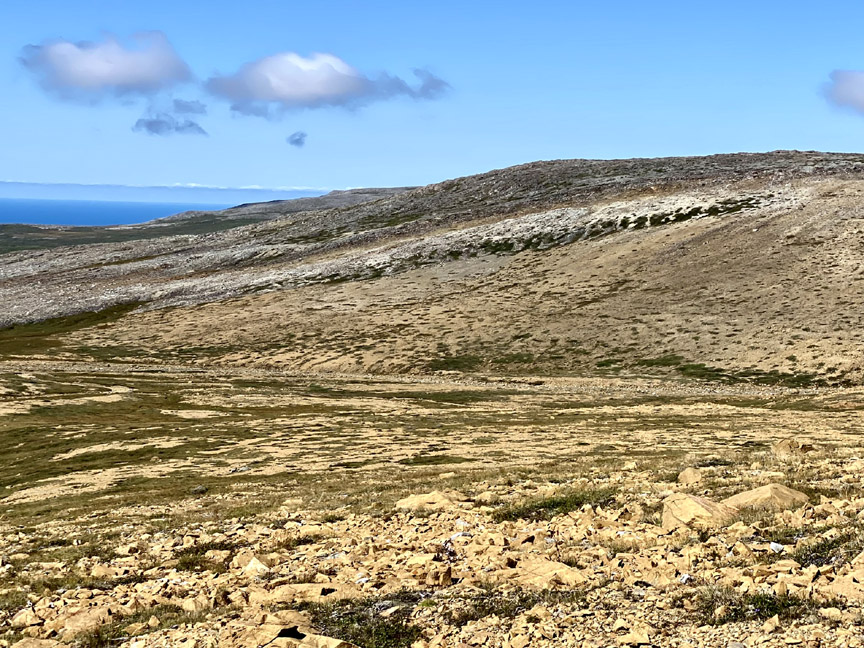
View back towards Moho Ridge
Before descending into the gulch via a gap in the canyon wall, a 1km round trip trek up a 50m-high slope provides a spectacular view south through the gulch toward Elephant Head, overlooking the narrows between Trout River inner and outer ponds.
The descent to the canyon floor is down a short scree field in a narrow gully. Immediately at left is a 130m (400ft) impassable waterfalls that drains the plateau and remaining winter snow and ice that can fill the shady depressions until mid summer.
From here it’s an easy 2 km stroll out of the gulch, past a winding cascade that turns east and empties into Trout River Pond.
After crossing the shallow stream, it is now just an easy 7 km (4 mile) stroll along a park trail to the wharf at the end of the pond. Another 2 kms on gravel road will take hikers to an ideal campground within striking distance of the Elephant.
Stage Two – North Arm Ophiolite – is the longest stage of the UltramaTrex at approximately 49km (29.5 miles) and can be completed in 2 to 3 days, depending on month and fitness. From the start at 30 meters (98 feet) elevation near Trout River Pond campground, the route follows an ATV trail for approx 5 kilometers (3 miles) before climbing up the side of the Elephant to a height of 400 meters (1,310 feet).
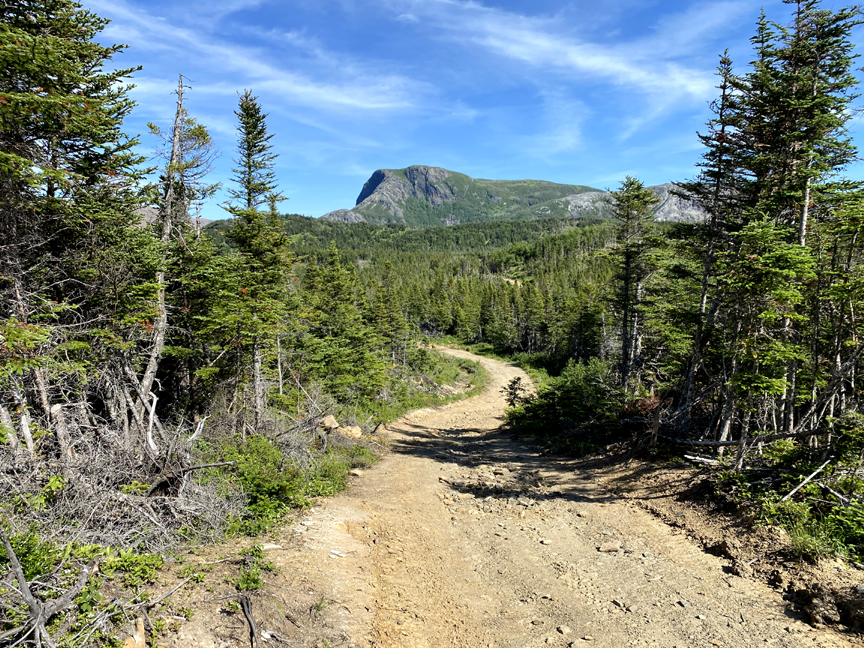
The plateau on top of the Elephant’s Head provides fantastic views of Table Mountain Massif (i.e., the Tablelands) and Trout River Pond, all the way to the town of Trout River on the gulf coast.
East of the Elephant Head, the trek along the south rim of Trout River fiord weaves and bobs around various small ponds and patches of tuck and scrub
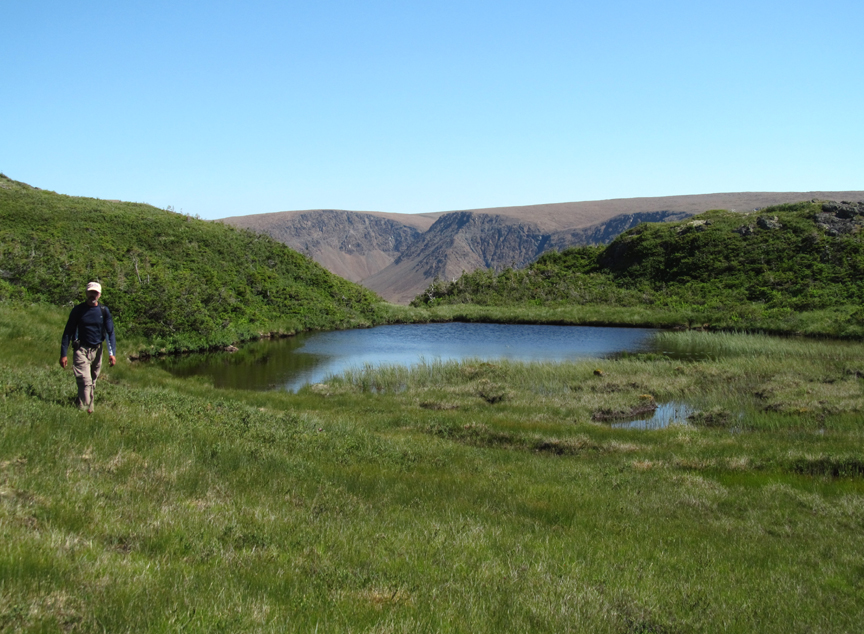
while stopping here and there to take in another view of the ridges and canyons of Table Mountain.
Near the end of the fiord, the route turns south and follows a series of mountaintop valleys that drain a number of large lakes, ponds and wetlands.
This is some of the most remote backcountry in Western Newfoundland, where it is much more likely to encounter a moose, caribou, arctic hare or black bear than a two-legged backpacker. But have no fear, like other friendly Newfoundlanders, the black bears and coywolfs here are quite harmless and more likely to run off in the opposite direction than approach with curiosity.
After 13 or 14 kilometers of this sub-arctic landscape, hikers once again encounter the Mars-like ultramafic mantle of the Bay of Islands Ophiolite
which is essentially devoid of trees and bushes but occasionally blanketed by large sections of wild grasslands perforated by small wetland ponds
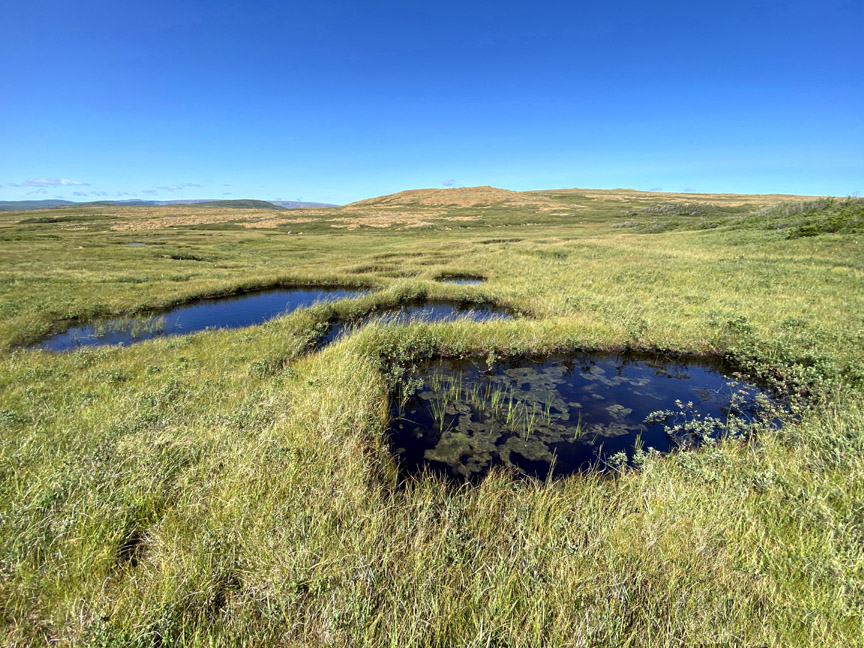
or bisected by single file caribou trails
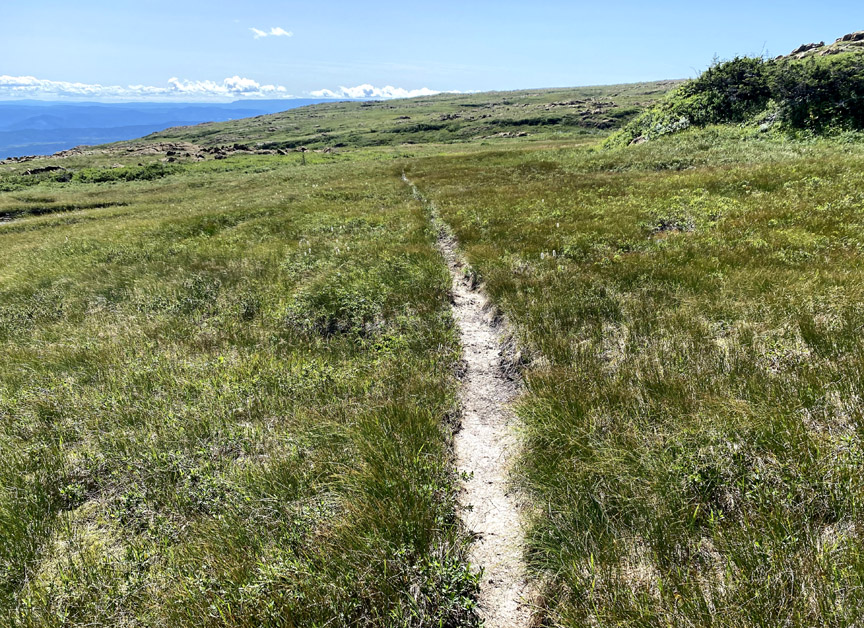
that wind their way around or down through the many gullies and ledges along the southeastern edge of North Arm Massif.
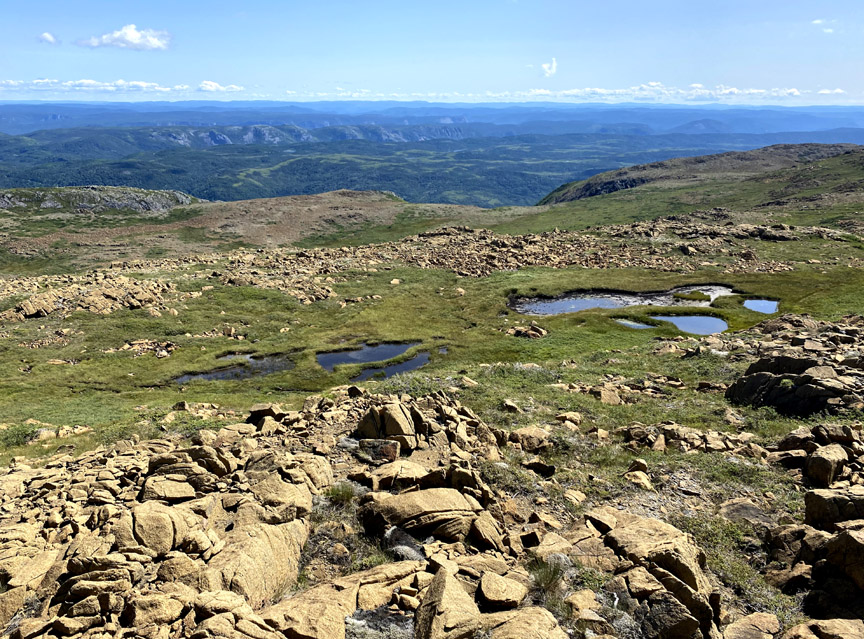
Before long hikers will traverse a rocky peridotite plateau that rises to 650 meters (2,130 feet)
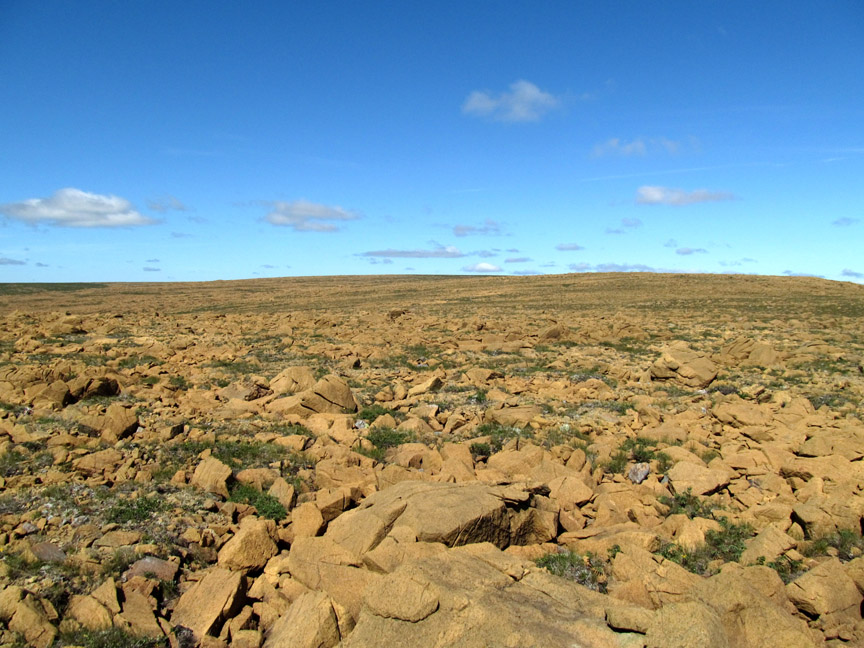
followed by spectacular views of North Arm and the outer Bay of Islands to the south and west
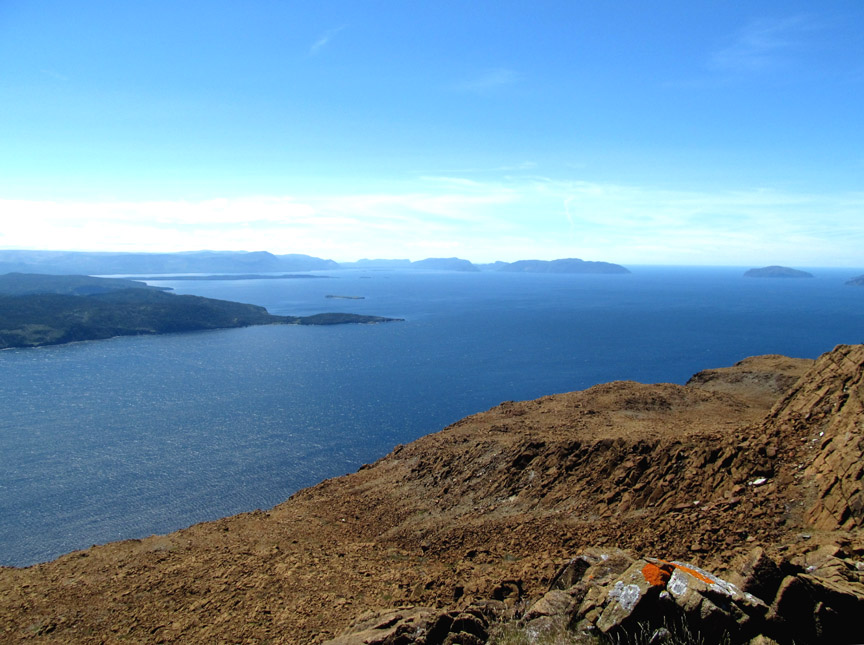
and Stowbridges Gulch to the north.
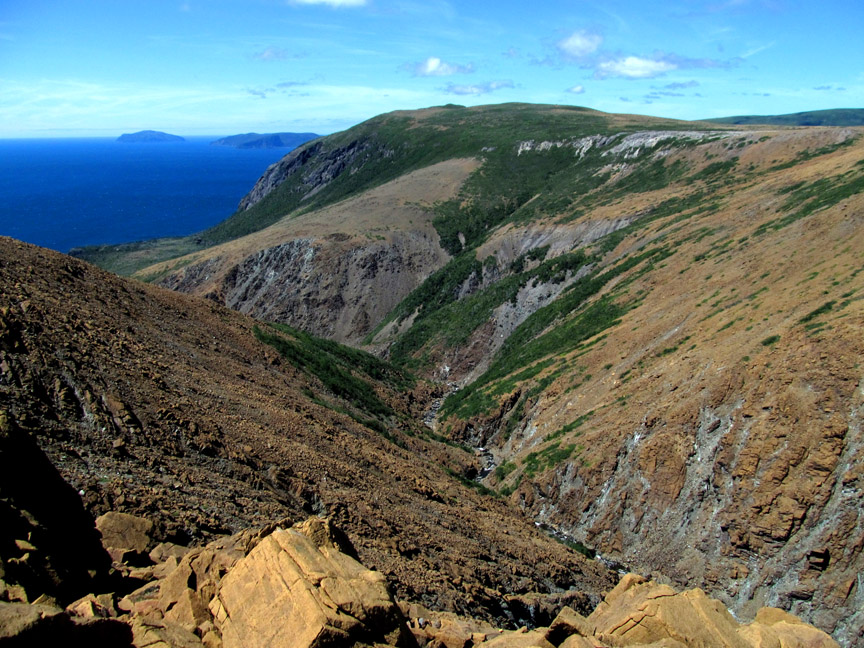
After descending a long slope to the west and walking a short distance around shore,
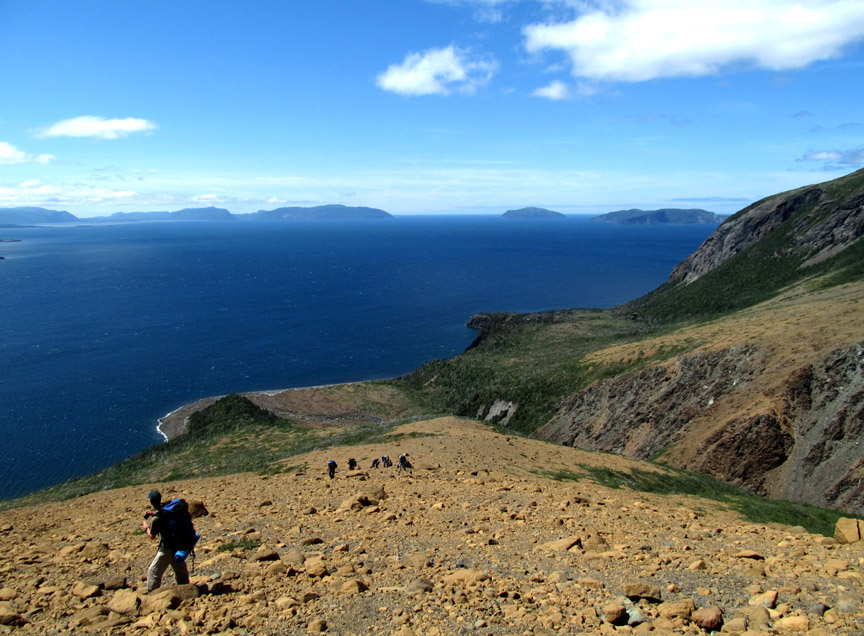
hikers will find an IATNL basecamp where they can arrange a night’s accommodation.
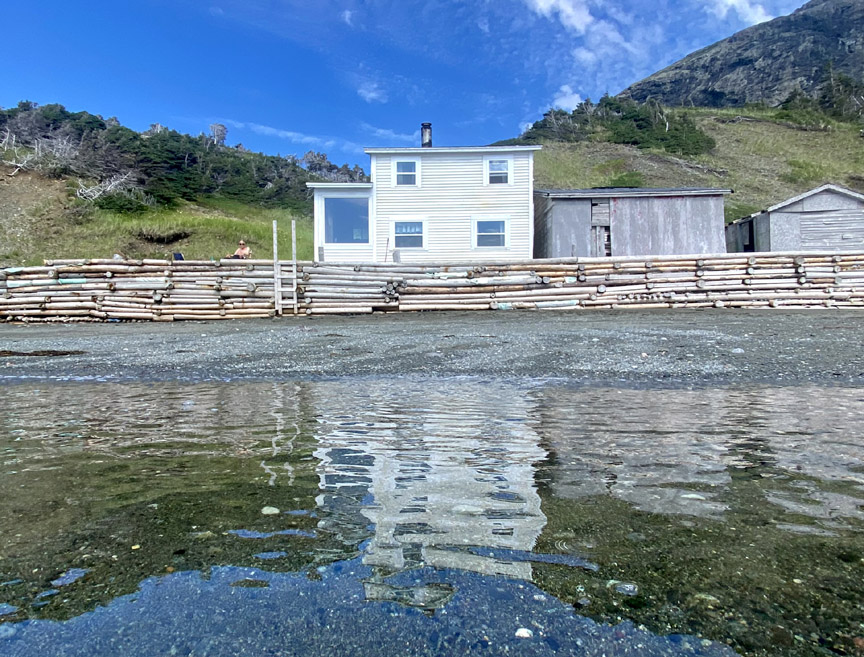
From the basecamp at Stowbridges, North Arm, it is necessary to take a boat ride – dory or zodiac – across the Bay of Islands to Benoit’s Cove in Humber Arm, or to Cox’s Cove in Middle Arm, then take ground transportation around the Humber Arm to Benoit’s Cove.
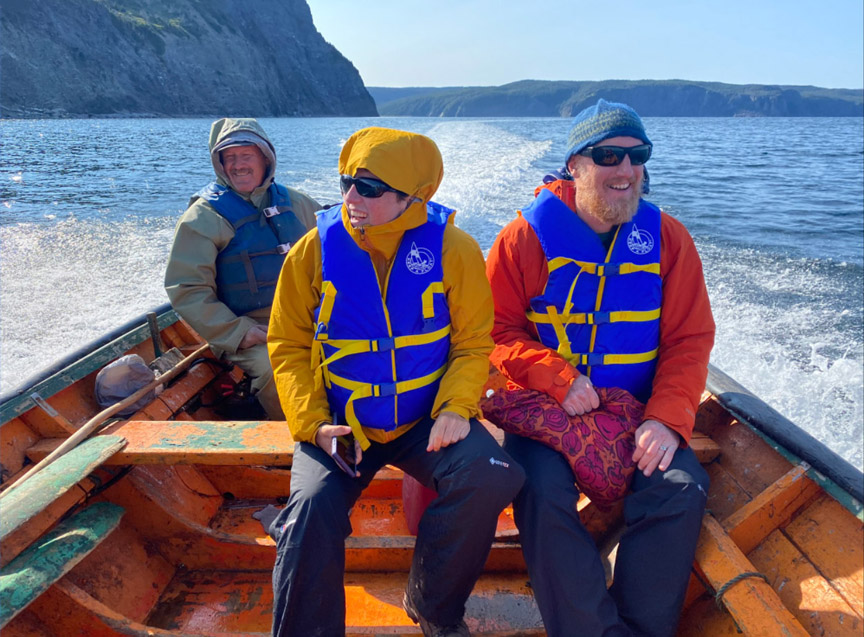
After crossing the Bay of Islands by boat (an approx one hour ride), Stage Three – Blow Me Down Massif – starts at sea level from the Cabox Information Center at Saltbox Restaurant in Benoit’s Cove.
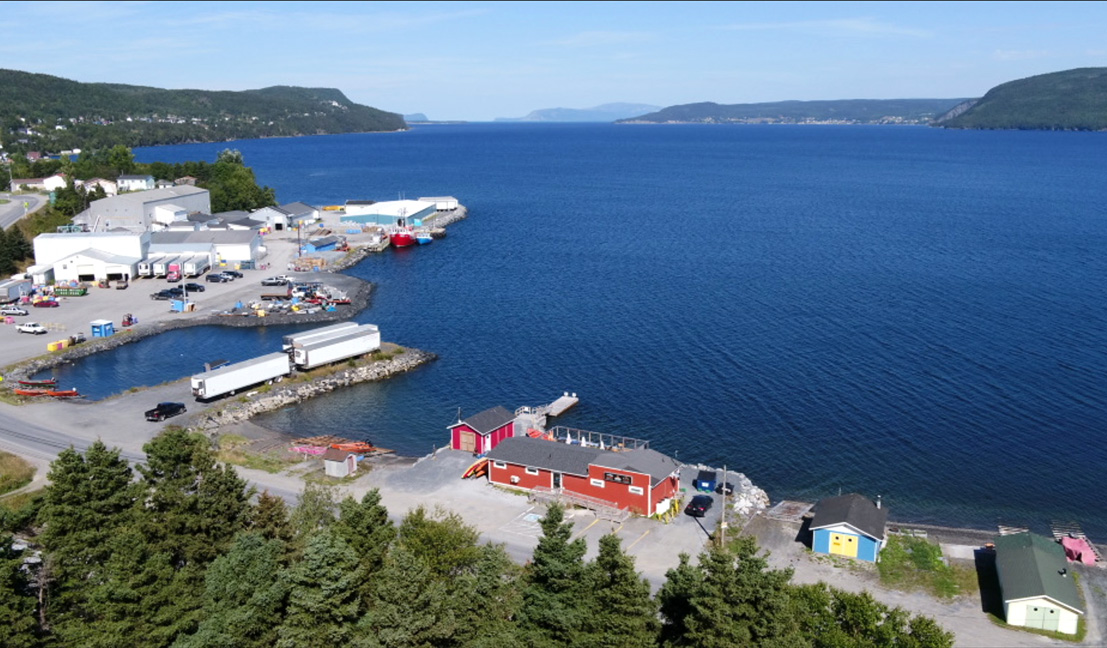
The 34 kilometer (20.5 mile) trek to the western end of Serpentine Lake begins with a 3km hike up a gravel forestry access road, followed by a 1km walk down the town’s water supply road,
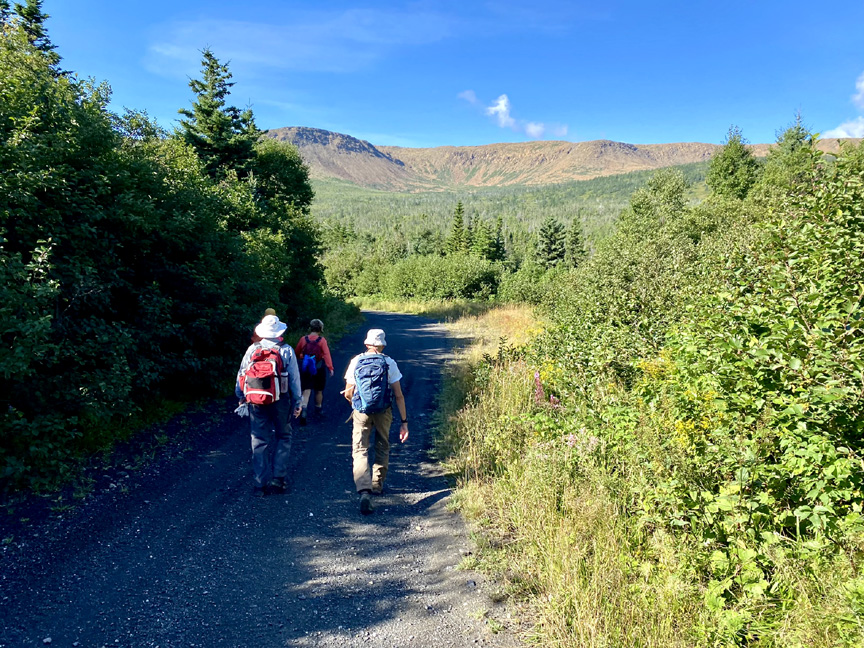
an ankle-to-knee-deep ford of Clark’s Brook,
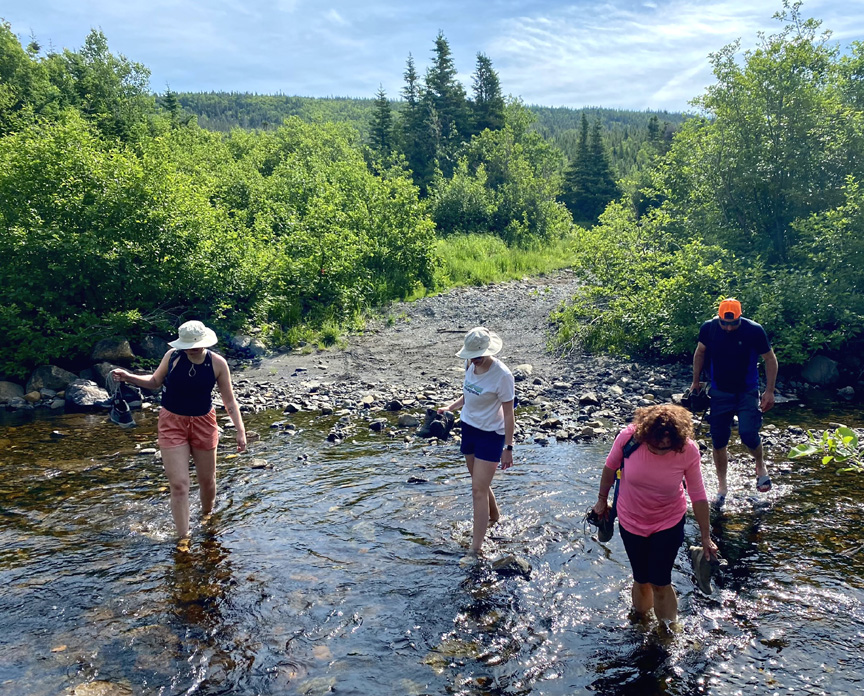
then a 1.5km trek up a rough excavator track to the base of the Blow Me Down Mountains.
From there the route winds its way up a small peridotite valley with a nice cross-sectional view of the mountains and Humber Arm
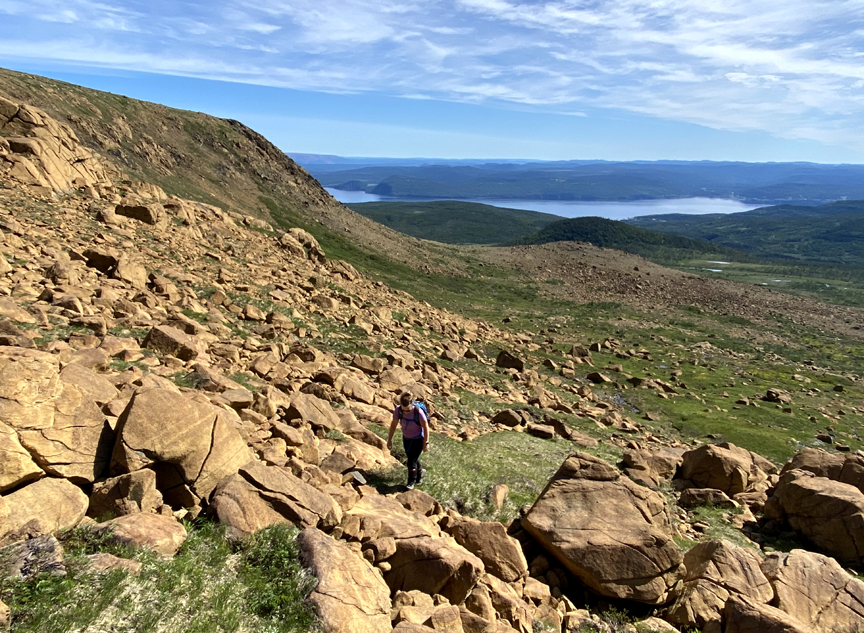
until it reaches a series of small ponds at top.
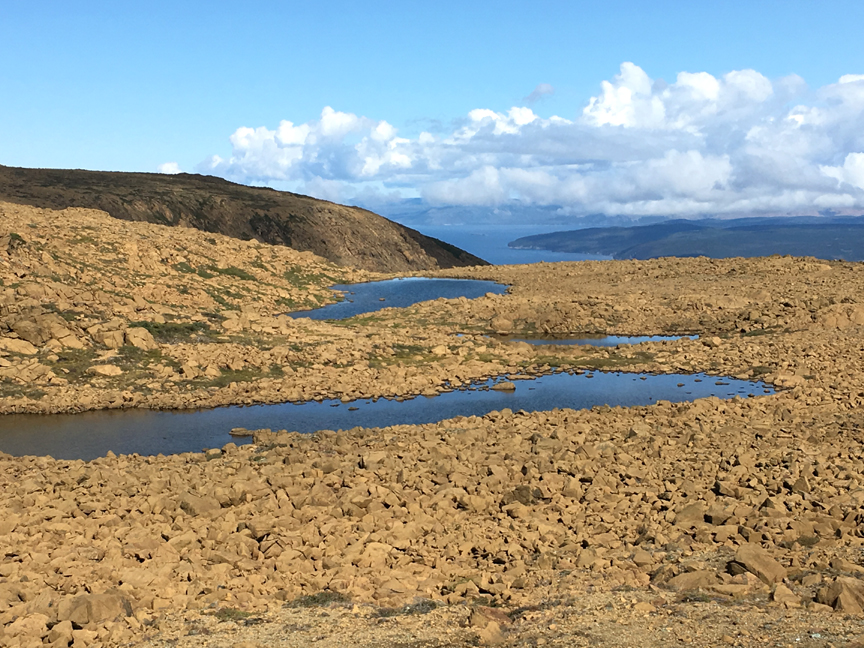
At this point the route turns north and follows the eastern edge of the mountains until it reaches the eastern flank of Charlie’s Bottom, which provides a panoramic view extending to the entrance of Blow Me Down Brook Gulch and the outer Bay of Islands beyond. In early summer, it is not unusual to see large patches of snow filling in the northeast depressions along the edge of the mountains.
After descending to the brook running down Charlie’s Bottom, hikers can take a short detour to a series of cascades, an ideal spot for a midday lunch or to cool off on a hot summer day after the snows have melted.
Once under way again, hikers must climb 200m (650ft) higher to the top of Charlie Bottom’s western flank, then after another 1km walk will be rewarded with a dramatic view of Blow Me Down Brook gulch, falls and south branch.
The main glacier-carved gulch also marks the geological boundary between ocean crust (primarily grey gabbro) to the north and earth’s mantle (primarily rust-colored peridotite) to the south.
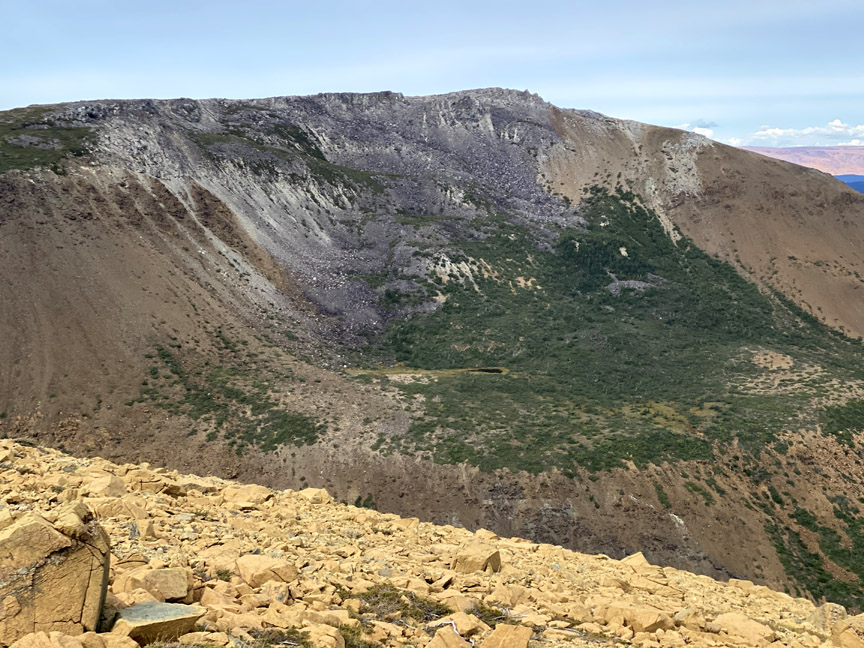
3.5 kms (2 miles) into the gulch at the back end of west branch, Blow Me Down Brook Falls is approximately 80m (260ft) high, with a wide deep pool at its base, ideal for a cool refreshing dip.
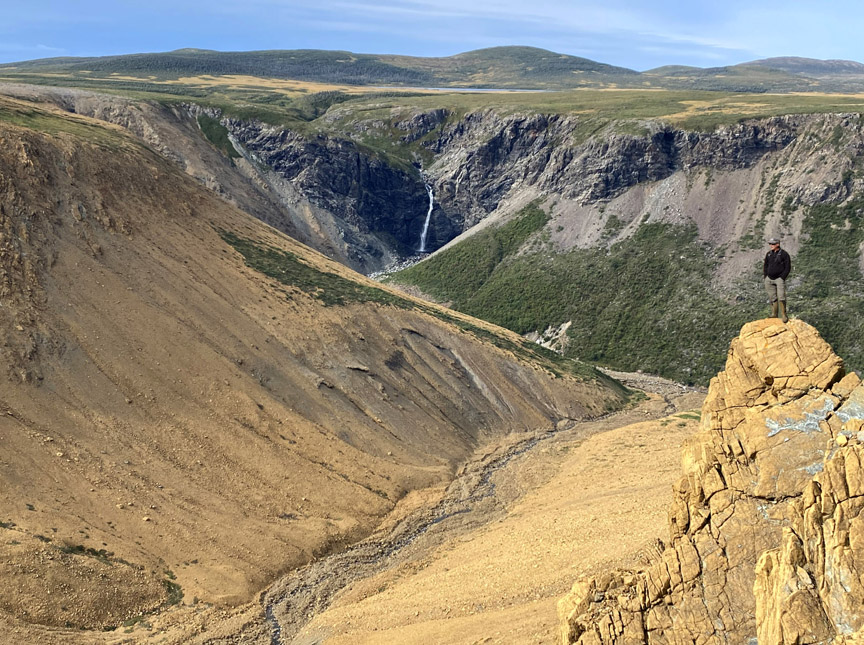
From the BMDB Falls viewpoint, the route turns south and follows along the east flank of South Branch, which provides spectacular views through a steep narrow canyon that’s impassable at its base.
Once at the back end of the gulch, the contours becomes more gentle and allow an easy crossing of south branch brook
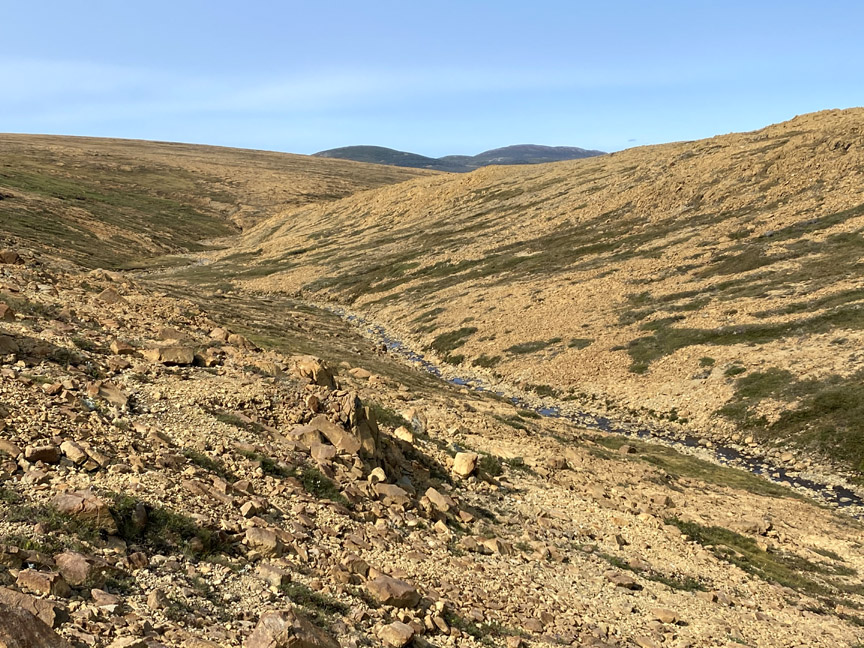
and last look at Blow Me Down Brook Gulch
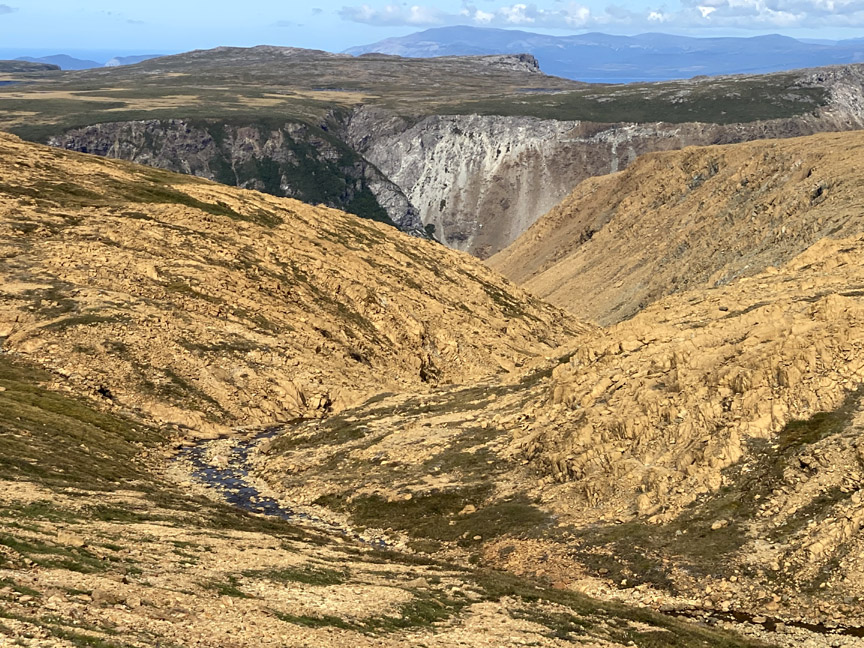
before the route turns southwest to cross the broad, rocky meadow at top center of the massif.
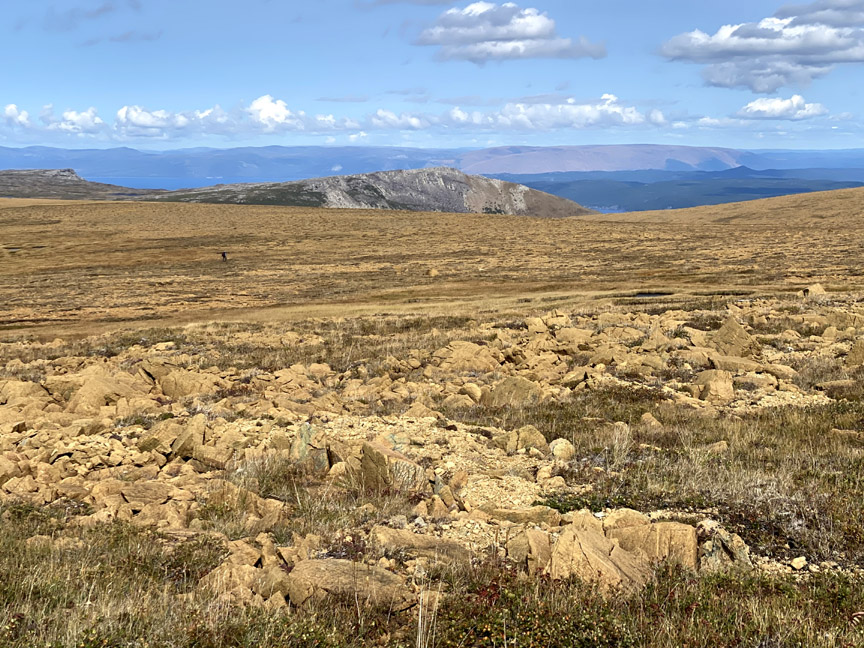
Before descending into the Simms Gulch watershed, the route passes a small, easily navigatable wetland
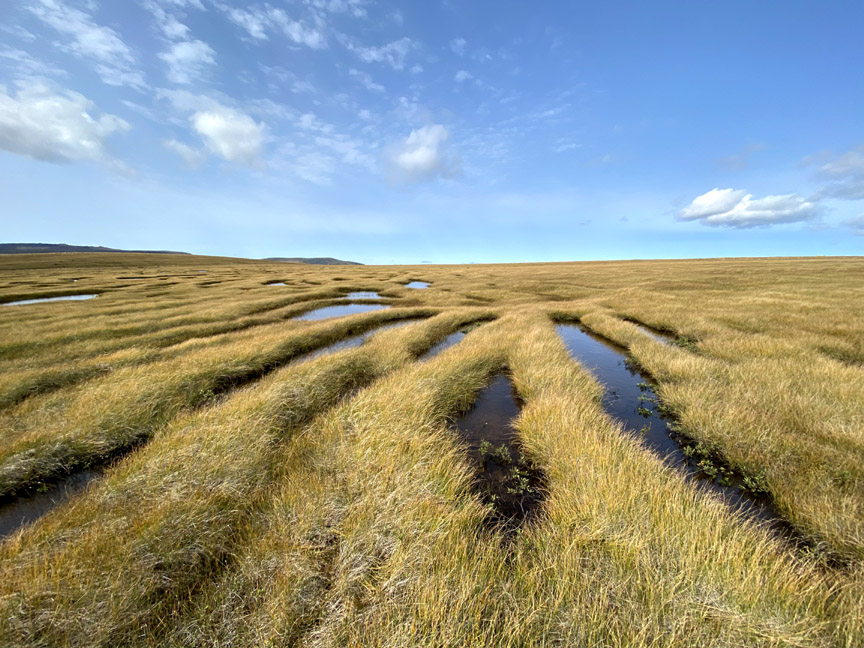
then follows the headwaters stream of Simms Gulch’s north branch
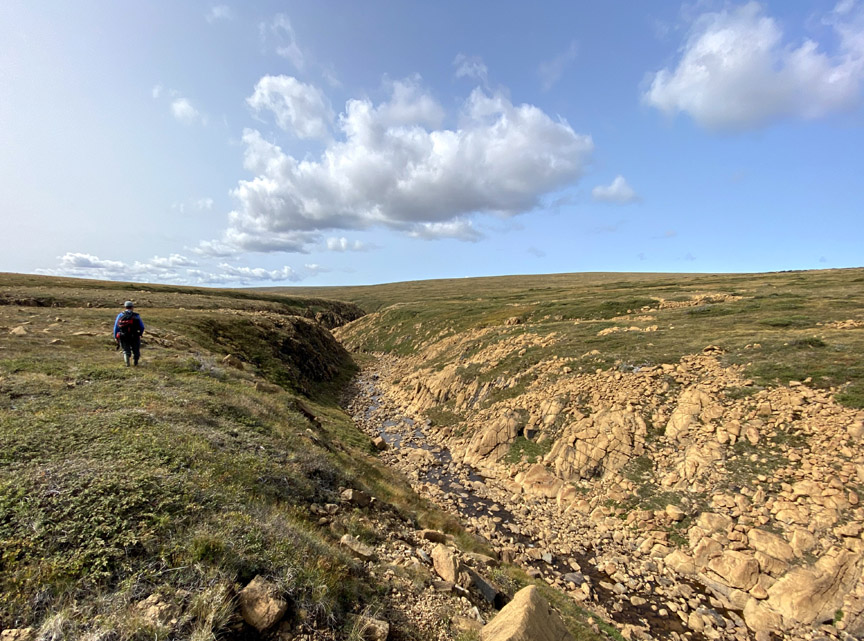
passing Three Sisters Waterfall
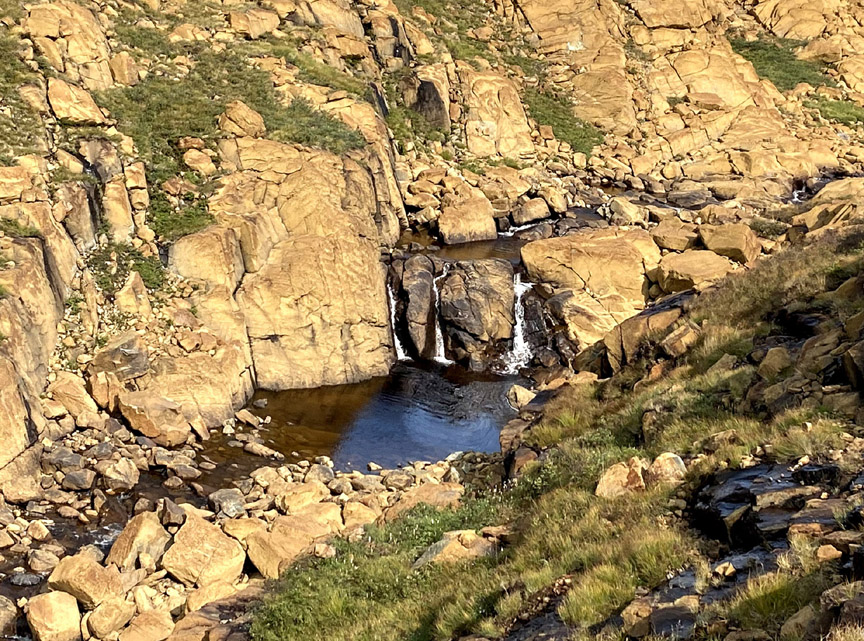
before descending into and out of Simms Gulch on a “stone glacier” of primarily ultramafic peridotite rocks that either tumbled down the steep eastern cliff wall or were washed down one of two upper tributaries that normally flow underground.
Like the northern slope of Blow Me Down Gulch, the western cliff wall of Simms Gulch is composed of a distinct light grey gabbro, part of the ocean floor of the ancient Iapetus Ocean.
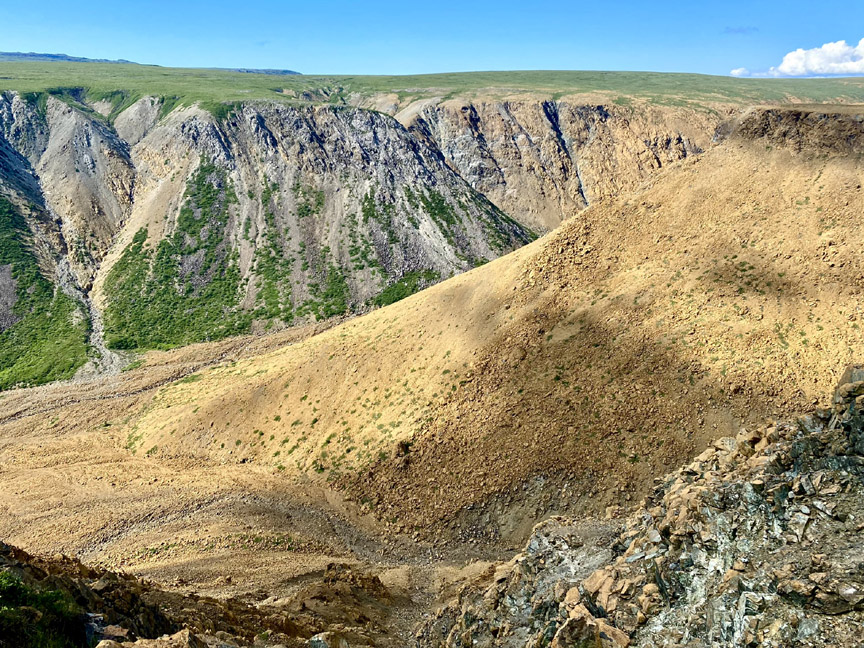
It extends all the way to the entrance to the gulch where it crosses the streambed and spans both sides of the canyon, which is approximately 300 meters (984 feet) at its narrowest and 600 meters (1,970 feet) at its widest, and rises from a height of 200 meters (655 feet) on the canyon floor to 600 meters (1,970 feet) on both flanks.
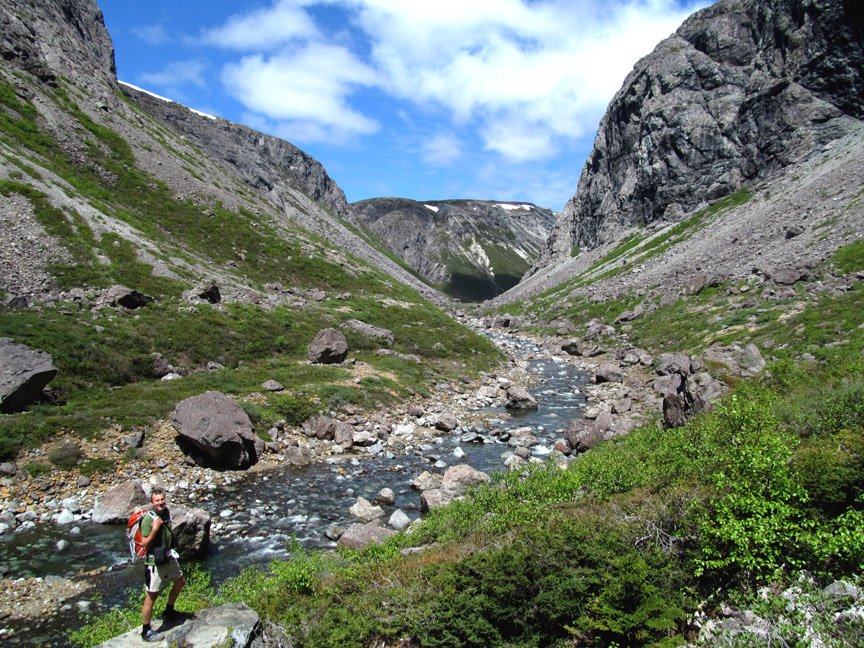
Leaving the gulch, hikers follow along the edge of Simms Brook before descending a trail through a coniferous forest to the shore of Serpentine Lake. Along the way a short detour can be made back to Simms Brook for a series of waterfalls that are a great place to cool off.
Once at the lake, hikers are reminded to cross to the other side by walking on a sandbar on the western end of the lake, not by crossing the deeper river a short distance away. This crossing is not recommended on foot before July, as winter snowmelt may raise the lake level to waist deep or higher. (Summer levels are normally between knee and thigh.) Once on the other side, the beach near the logging road is a great place to camp for the night.
Stage Four – Lewis Hills Massif – begins with a 2.5 kilometer (1.5 mile) walk on a gravel backcountry road to the IATNL trailhead for the Lewis Hills Trail. After a shallow stream crossing and 2 kilometer (1.25 mile) trek up a forested trail to the base of the mountains, hikers are afforded a terrific view of the route from Simms Gulch
before navigating around boulders and across another stream until they reach the entrance to Red Rocky Gulch and another Mars-like peridotite landscape from the earth’s mantle.
From there they turn west into the gulch for a 5 kilometer (3 mile) trek that begins by walking on small rocks along the side of a brook and ends by weaving around large boulders on the west bank of the upper gulch, which rises to an elevation of 620 meters (2,035 feet).
Once in the high country above 500 meters (1,640 ft), it is quite possible to cross snow fields in summer and discover an ice cave with cool shade on a hot day.
Just 3 kilometers (2 miles) from the top of Red Rocky Gulch is the back end of Rope Cove Canyon, which affords a magnificent view of a multi-colored valley composed of peridotite on the southern end and mafic gneiss and amphibolite of the Mount Barren Complex on the northern end, with the Gulf of St Lawrence in the background. This is a good place to camp for the night, with a small stream to cook and wash.
Day Two of this stage is a 19 kilometer (12 mile) trek that begins with a sweeping vista into the upper reaches of Fox Island River and its tributaries
before climbing to the Cabox, at 814 meters (2,670 feet) the highest point on the island of Newfoundland. Lucky hikers may encounter a family of caribou resting there in the midday sun.
An alternate route to the Cabox from Rope Cove Canyon is via Molly Ann Gulch, just a short distance away but in the substantially different Mount Barren geological formation
where like Rope Cove Canyon, campers may be fortunate enough to watch the sun set into the Gulf of St Lawrence.
No matter what route you take to the summit, it’s all downhill from there! … first across a broad gentle slope
then down another peridotite gulch than ends in a series of crystal-clear cascading pools that drain into Fox Island River.
An easy crossing of the shallow river is followed by a 160 meter (525 feet) climb up a moderate slope providing a good view of the mountains and river
then a level hike around a grassy bog, then half kilometer trek along a forest trail to the southern trailhead of the IATNL Lewis Hills Trail.
Be sure to arrange transportation from this point, which is generally a 1.3 hour drive over a gravel backcountry road in an SUV or pickup truck.
For more on the UltramaTrex, go to IATNL.org

